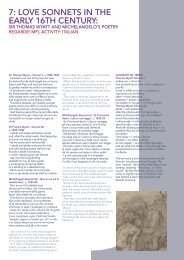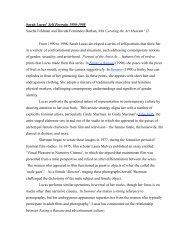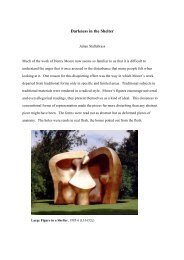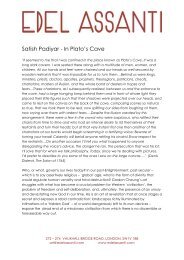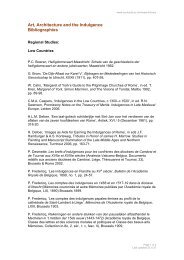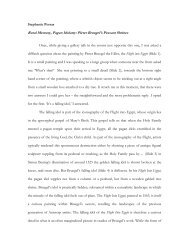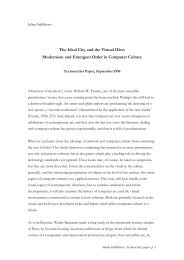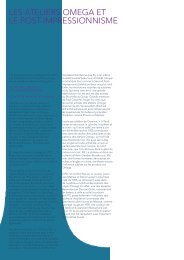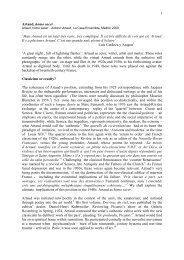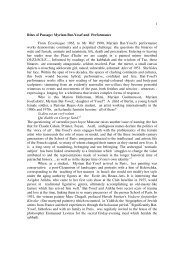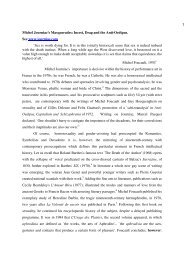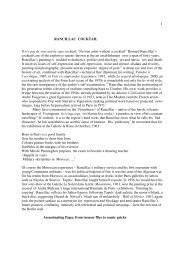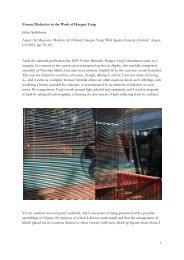Fabrics for the twenty-first century - The Courtauld Institute of Art
Fabrics for the twenty-first century - The Courtauld Institute of Art
Fabrics for the twenty-first century - The Courtauld Institute of Art
You also want an ePaper? Increase the reach of your titles
YUMPU automatically turns print PDFs into web optimized ePapers that Google loves.
Original research or treatment paper<br />
<strong>Fabrics</strong> <strong>for</strong> <strong>the</strong> <strong>twenty</strong>-<strong>first</strong> <strong>century</strong>: As artist<br />
canvas and <strong>for</strong> <strong>the</strong> structural rein<strong>for</strong>cement<br />
<strong>of</strong> easel paintings on canvas<br />
Christina Young, Suzanne Jardine<br />
<strong>Courtauld</strong> <strong>Institute</strong> <strong>of</strong> <strong>Art</strong>, London, UK<br />
<strong>The</strong> requirements <strong>for</strong>, and assessment <strong>of</strong>, suitable fabrics <strong>for</strong> artist canvas and <strong>for</strong> <strong>the</strong> structural rein<strong>for</strong>cement<br />
<strong>of</strong> easel paintings on canvas are presented. Crucially, <strong>the</strong> aes<strong>the</strong>tic and kinaes<strong>the</strong>tic, as well as physical<br />
properties <strong>of</strong> <strong>the</strong> canvas fabrics have been taken into account. To evaluate <strong>the</strong> fabrics <strong>the</strong> following<br />
properties were measured: stiffness, ultimate tensile strength, moisture response, crimp, drape, and lustre.<br />
<strong>Fabrics</strong> investigated include cotton, linen, polyester, polyamides, and carbonized fibres. Although<br />
polyester is yet to match linen or cotton kinaes<strong>the</strong>tically or aes<strong>the</strong>tically, overall it exhibits <strong>the</strong> best<br />
combination <strong>of</strong> properties. However, <strong>the</strong> results have shown that even when raw fibre material has suitable<br />
properties <strong>the</strong> finished woven fabric may not. This is because <strong>of</strong> <strong>the</strong> strong influence <strong>of</strong> <strong>the</strong> woven<br />
geometry on <strong>the</strong> final behaviour. It has been found that drape and lustre are very good properties to<br />
quantify some aspects <strong>of</strong> <strong>the</strong> feel and look <strong>of</strong> fabrics, in <strong>the</strong> context <strong>of</strong> conservation, and to provide a<br />
common language to ensure that <strong>the</strong> specification incorporates <strong>the</strong>se aspects.<br />
Keywords: Canvas, Design, Lining, Mechanical, Aes<strong>the</strong>tic, <strong>Art</strong>ist, Twenty-<strong>first</strong> <strong>century</strong><br />
Introduction<br />
It has been 20 years since a wide range <strong>of</strong> fabrics<br />
(including polyester, nylon, and fibreglass) were<br />
tested to find options o<strong>the</strong>r than linen and cotton <strong>for</strong><br />
<strong>the</strong> lining <strong>of</strong> paintings (Hedley, 1981). Following<br />
fur<strong>the</strong>r research, it was suggested that woven polyester<br />
was <strong>the</strong> most promising fabric (Hedley, 1982).<br />
Subsequent smaller studies have investigated suitable<br />
syn<strong>the</strong>tic fabrics; some <strong>of</strong> <strong>the</strong>se have been adopted<br />
<strong>for</strong> short periods but have not found wide-scale acceptance<br />
(Ackroyd, 2002; Hapgood, 2007; Legris, 2009).<br />
Manufacturers and suppliers <strong>of</strong> artists’ materials<br />
have also looked, with some success, <strong>for</strong> solutions to<br />
mitigate <strong>the</strong> problem <strong>of</strong> <strong>the</strong> moisture response and<br />
degradation <strong>of</strong> natural fabrics (Labreuche, 2011).<br />
However, during <strong>the</strong> same period, sophisticated<br />
fabrics have been developed <strong>for</strong> <strong>the</strong> aerospace, military,<br />
and sports industries and, in <strong>the</strong> <strong>twenty</strong>-<strong>first</strong><br />
<strong>century</strong>, advances in printing technology <strong>for</strong> graphic<br />
design applications have pushed <strong>the</strong> development in<br />
artist canvas. <strong>The</strong>se developments, combined with<br />
<strong>the</strong> continuing trend <strong>for</strong> perceived minimally invasive<br />
methods and artists’ continuing exploration and<br />
Correspondence to: Christina Young, <strong>Courtauld</strong> <strong>Institute</strong> <strong>of</strong> <strong>Art</strong>, Somerset<br />
House, Strand, London WC2R ORN, UK.<br />
Email: christina.young@courtauld.ac.uk<br />
manipulation <strong>of</strong> canvas, suggest that it is timely to<br />
reassess what alternatives are available and what properties<br />
we require <strong>of</strong> such fabrics. This paper reports on<br />
one aspect <strong>of</strong> a two-year research project into <strong>the</strong> specification<br />
and assessment <strong>of</strong> fabrics in tension <strong>for</strong><br />
architectural enclosures, artist canvas, and <strong>for</strong> <strong>the</strong><br />
structural rein<strong>for</strong>cement <strong>of</strong> paintings on canvas. One<br />
object <strong>of</strong> <strong>the</strong> project was to design and/or identify a<br />
suite <strong>of</strong> fabrics, useful <strong>for</strong> conservators and artists,<br />
which met both <strong>the</strong> conservation requirements in<br />
terms <strong>of</strong> physical properties, and <strong>the</strong> required aes<strong>the</strong>tic<br />
and kinaes<strong>the</strong>tic properties, properties mainly lacking<br />
in <strong>the</strong> available syn<strong>the</strong>tic alternatives to natural linen<br />
and cotton canvas.<br />
An important aspect <strong>of</strong> this work was to include, at<br />
<strong>the</strong> specification stage, <strong>the</strong> opinions and knowledge<br />
<strong>of</strong> conservators, internationally, who are regularly<br />
involved in <strong>the</strong> structural treatment <strong>of</strong> canvas paintings.<br />
Twelve such conservators answered <strong>the</strong> questionnaire<br />
(which allowed <strong>for</strong> three different scenarios and<br />
all aspects <strong>of</strong> <strong>the</strong> requirements <strong>of</strong> <strong>the</strong> fabrics).<br />
Discussions with a fur<strong>the</strong>r ten such conservators,<br />
fabric suppliers and manufacturers, and ten years <strong>of</strong><br />
experience <strong>of</strong> treating paintings and testing materials<br />
in <strong>the</strong> Conservation and Technology department at<br />
<strong>The</strong> <strong>Courtauld</strong>, <strong>for</strong>med <strong>the</strong> basis <strong>for</strong> <strong>the</strong> requirements<br />
© <strong>The</strong> International <strong>Institute</strong> <strong>for</strong> Conservation <strong>of</strong> Historic and <strong>Art</strong>istic Works 2012<br />
DOI 10.1179/2047058412Y.0000000007 Studies in Conservation 2012 VOL. 0 NO. 0 1
Young and Jardine <strong>Fabrics</strong> <strong>for</strong> <strong>the</strong> <strong>twenty</strong>-<strong>first</strong> <strong>century</strong><br />
2<br />
and assessment criteria <strong>for</strong> <strong>the</strong> fabrics. Not surprisingly,<br />
a predominant requirement that arose was <strong>for</strong> a fabric<br />
that had <strong>the</strong> mechanical properties and minimal<br />
moisture response <strong>of</strong> <strong>the</strong> existing ‘restoration’ polyester<br />
sailcloth but <strong>the</strong> look and feel <strong>of</strong> linen. Replies to <strong>the</strong><br />
questionnaire, and feedback at a canvas workshop<br />
held at <strong>The</strong> <strong>Courtauld</strong>, indicated that <strong>the</strong> fabric properties<br />
that were considered very important by more than<br />
50% <strong>of</strong> <strong>the</strong> conservators were: a linen lookalike,<br />
good handling properties, dimensional stability, and<br />
minimal response to moisture. <strong>The</strong> next most important<br />
criteria were <strong>the</strong> demands <strong>of</strong> <strong>the</strong> client <strong>for</strong> a ‘sympa<strong>the</strong>tic<br />
look’ and <strong>the</strong> need <strong>for</strong> a stiff fabric to hold down<br />
cupping and tears. In all but three <strong>of</strong> <strong>the</strong> 36 treatments<br />
described by conservators, <strong>the</strong> adhesive used <strong>for</strong> strip<br />
lining or full lining was BEVA 371. An interest in a<br />
stiff but thin fabric <strong>for</strong> interleafs was also highlighted.<br />
Surprisingly, a fabric with minimal degradation was<br />
not felt to be a high priority but it was clear that preventive<br />
measures including deacidification, stretcher bar<br />
linings, and air filtering <strong>of</strong> pollutants were thought to<br />
mitigate some <strong>of</strong> <strong>the</strong> causes <strong>of</strong> degradation <strong>of</strong> linen<br />
and cotton. Essentially, <strong>the</strong> desired properties have<br />
changed little from those specified by Hedley (1981)<br />
over 30 years ago.<br />
<strong>The</strong> requirement <strong>for</strong> fabrics in conservation applications<br />
to have long-term stability and longevity, <strong>for</strong><br />
instance, over 25 years (Ackroyd & Villers, 2003), is<br />
not normally applied by fabric manufacturers. <strong>The</strong>y<br />
use <strong>the</strong> BS (British Standards), ISO (International<br />
Organization <strong>for</strong> Standardization), or ASTM<br />
(American Society <strong>for</strong> Testing and Materials) standards,<br />
which are per<strong>for</strong>mance tests based on industrial<br />
applications <strong>for</strong> fabrics requiring shorter service lives,<br />
hence <strong>the</strong>se data are usually insufficient. <strong>The</strong>re<strong>for</strong>e, it<br />
is necessary to collaborate with <strong>the</strong> manufacturers to<br />
in<strong>for</strong>m <strong>the</strong>m <strong>of</strong> specific conservation requirements<br />
and <strong>for</strong> <strong>the</strong>m to in<strong>for</strong>m us <strong>of</strong> practical limitations in<br />
<strong>the</strong> manufacturing process. Heathcoat <strong>Fabrics</strong> (incorporating<br />
Haywoods Ltd) was <strong>the</strong> <strong>Courtauld</strong> industrial<br />
partner <strong>for</strong> this research. <strong>The</strong>y are <strong>the</strong> manufacturers<br />
<strong>of</strong> <strong>the</strong> polyester sailcloth modified <strong>for</strong> use as a ‘restoration’<br />
fabric, L00169. <strong>The</strong>y agreed to produce fabric to<br />
our requirements using existing fabrics as a starting<br />
point. A polyester plain weave fabric was chosen<br />
from <strong>the</strong>ir product range because it had similar feel<br />
and weight as medium-weight linen. However, it was<br />
anisotropic and modification to <strong>the</strong> material did not<br />
improve its properties. No fur<strong>the</strong>r prototypes could<br />
be manufactured within <strong>the</strong> timescale <strong>of</strong> <strong>the</strong> project.<br />
<strong>The</strong>re are many parameters that can be altered in<br />
<strong>the</strong> manufacturing process. <strong>The</strong>se include choosing<br />
between continuous or spun yarns, spin direction<br />
and degree <strong>of</strong> twist <strong>of</strong> <strong>the</strong> yarn, <strong>the</strong> yarn diameter<br />
and density in each direction, <strong>the</strong> tension in each direction<br />
while weaving, additional finishing processes, and<br />
Studies in Conservation 2012 VOL. 0 NO. 0<br />
surface modifications. It would appear from discussions<br />
with a number <strong>of</strong> manufacturers that altering<br />
<strong>the</strong>se physical parameters to modify <strong>the</strong> physical properties<br />
<strong>of</strong> <strong>the</strong> fabric is, to some degree, an empirical<br />
process. This is partly because design s<strong>of</strong>tware that<br />
uses modelling <strong>of</strong> <strong>the</strong> complex woven structure <strong>of</strong><br />
fabric is still to be fully developed (Tan et al., 1997;<br />
Manjit, 2009). Thus, <strong>the</strong> specification, manufacture,<br />
and testing <strong>of</strong> a new fabric is a slow iterative process.<br />
This factor combined with <strong>the</strong> small volumes required<br />
<strong>for</strong> testing meant that modifying existing fabrics was<br />
more efficient than starting from scratch. Thus, <strong>the</strong><br />
original objective <strong>of</strong> a design specification developed<br />
into a list <strong>of</strong> desirable requirements.<br />
Fabric selection<br />
A range <strong>of</strong> potential fabrics, including woven and<br />
non-woven, were surveyed. Twill weave confers<br />
greater dimensional stability than plain weave.<br />
However, no suitable syn<strong>the</strong>tic twill fabrics were<br />
readily available <strong>for</strong> testing. Triaxial woven fabrics<br />
(<strong>the</strong> third set <strong>of</strong> yarns at 45°) were <strong>of</strong> interest because<br />
<strong>the</strong>y provide greater stability and strength in <strong>the</strong> bias<br />
direction (Scardino & Ko, 1981). This is <strong>the</strong> direction<br />
where <strong>the</strong> design <strong>of</strong> <strong>the</strong> stretcher and keying-out causes<br />
greatest stress (Young, 1996a). However, triaxial<br />
weaving looms are rare and a manufacturer was not<br />
found who could weave a fabric <strong>of</strong> appropriate type<br />
or weight <strong>for</strong> this application. Such fabrics could<br />
<strong>of</strong>fer great potential in <strong>the</strong> future. Non-woven fabrics<br />
were not evaluated experimentally as part <strong>of</strong> this<br />
research because a preliminary survey found that<br />
<strong>the</strong>y do not have good drape and have a tendency<br />
to creep (Das et al., 2005). Additionally, <strong>the</strong> resin<br />
binders in bonded non-woven fabrics may not have<br />
<strong>the</strong> required long-term stability (Aslanzadeh &<br />
Haghighat, 1990; Dupuis et al., 1991).<br />
A survey was made <strong>of</strong> commercially available<br />
uncoated plain woven fabrics in all fibre types from<br />
9 to 15 oz in weight with relatively even weave count.<br />
Fifty were found that met <strong>the</strong>se criteria. Using data<br />
sheets and handling swatches from different suppliers,<br />
25 were found empirically from our own experience to<br />
be <strong>of</strong> similar stiffness, thickness, and flexibility to existing<br />
conservation fabrics. <strong>The</strong>se 25 underwent uniaxial<br />
testing to eliminate fabrics where <strong>the</strong> warp and weft<br />
stiffness were found to be uneven or where <strong>the</strong>re was<br />
a very large bias extension. This narrowed <strong>the</strong> group<br />
down to a subset <strong>of</strong> 15 fabrics <strong>for</strong> full testing, which<br />
included traditional and syn<strong>the</strong>tic fabrics regularly<br />
used at present, and <strong>the</strong> most promising new fabrics.<br />
This category included fabrics sourced by conservators<br />
which <strong>the</strong>y felt had aes<strong>the</strong>tic and kinaes<strong>the</strong>tic potential,<br />
but <strong>for</strong> which <strong>the</strong>re were insufficient data to evaluate<br />
(Buzzegoli, 2008). Commercially available primed and<br />
unprimed polyester fabric provided a good starting
point <strong>for</strong> an artist canvas. For comparison, two grades<br />
<strong>of</strong> Belgium linen were also included in <strong>the</strong> majority <strong>of</strong><br />
<strong>the</strong> tests because <strong>the</strong>y are both used as artist canvas and<br />
as lining fabrics. <strong>The</strong> raw material types fully tested<br />
were cotton, linen, polyester in polyethylene terephthalate<br />
<strong>for</strong>m (PET), polyamide (DuPont TM Kevlar ® and<br />
Nylon 6,6), and carbonized polyamide. Details <strong>of</strong> <strong>the</strong><br />
fabrics are given in Table 1.<br />
It should be noted that some fabrics were supplied<br />
without additional coatings that would normally be<br />
added to <strong>the</strong> commercial product such as fire retardants<br />
(see Appendix 1), nor were <strong>the</strong> linen and cotton duck<br />
wetted and stretched to ‘decrimp’ by <strong>the</strong> authors<br />
be<strong>for</strong>e testing. As is known empirically, and shown<br />
experimentally (<strong>for</strong> natural fabrics which absorb a<br />
greater amount <strong>of</strong> water than syn<strong>the</strong>tic fabrics) this<br />
‘decrimping’ process can result in <strong>the</strong> warp and weft<br />
stiffness becoming more similar (Young, 1996b;<br />
Young & Hibberd, 1999). Water is absorbed into<br />
fibres through bounding <strong>of</strong> <strong>the</strong>ir polar functional<br />
groups in <strong>the</strong> amorphous regions <strong>of</strong> <strong>the</strong>ir polymer<br />
structures. In <strong>the</strong> crystalline regions water cannot<br />
easily penetrate because <strong>of</strong> <strong>the</strong> closely packed structure<br />
and cross-linking <strong>of</strong> <strong>the</strong> molecules (Tímár-Balázsy,<br />
1999). Syn<strong>the</strong>tic fibres have a lower proportion <strong>of</strong><br />
polar groups in <strong>the</strong>ir amorphous region compared to<br />
natural fibres, and <strong>the</strong>ir degree <strong>of</strong> crystallinity is <strong>of</strong>ten<br />
higher (Morton & Hearle, 1993; Tímár-Balázsy,<br />
1999). <strong>The</strong>re<strong>for</strong>e, wetting and stretching should not<br />
produce a permanent change <strong>for</strong> <strong>the</strong> syn<strong>the</strong>tic materials<br />
tested. However, lubrication <strong>of</strong> <strong>the</strong> yarns in <strong>the</strong> woven<br />
fabric does affect <strong>the</strong>ir tension (Young, 1996a).<br />
Measured properties <strong>of</strong> <strong>the</strong> fabrics<br />
<strong>The</strong> properties chosen to be measured were stiffness,<br />
strength, moisture response, crimp, drape, and lustre.<br />
<strong>The</strong> mechanical and physical properties <strong>of</strong> <strong>the</strong><br />
fabrics were measured <strong>for</strong> <strong>the</strong> bulk woven fabric<br />
ra<strong>the</strong>r than <strong>the</strong> yarns or fibres e.g. stiffness (uniaxial,<br />
biaxial, and Young’s modulus). <strong>The</strong> relative degree<br />
<strong>of</strong> degradation <strong>of</strong> <strong>the</strong> fabrics chosen has been<br />
assumed from <strong>the</strong> published literature (National<br />
Research Council, 1992). However, finishing processes<br />
may play a role ei<strong>the</strong>r in protecting or hastening degradation.<br />
It was decided that measurement <strong>of</strong> <strong>the</strong> moisture<br />
response <strong>of</strong> <strong>the</strong> woven fabric under biaxial restraint<br />
was more pertinent to this application than using published<br />
equilibrium moisture content values <strong>for</strong> yarns.<br />
<strong>The</strong> degree <strong>of</strong> <strong>the</strong> crimp <strong>of</strong> <strong>the</strong> yarns is thought to<br />
have an influence on <strong>the</strong> bulk properties <strong>of</strong> fabrics at<br />
low load, and thus it was measured in <strong>the</strong> warp and<br />
weft directions. Continuous or spun yarns were identified<br />
(using optical microscopy at 20× magnification)<br />
in each direction because <strong>the</strong>y affect <strong>the</strong> moisture<br />
response, feel, and appearance. To provide a quantitative<br />
measure <strong>of</strong> <strong>the</strong> feel and look <strong>of</strong> <strong>the</strong> fabrics two<br />
Young and Jardine <strong>Fabrics</strong> <strong>for</strong> <strong>the</strong> <strong>twenty</strong>-<strong>first</strong> <strong>century</strong><br />
parameters were chosen that are used by <strong>the</strong> apparel<br />
industry; <strong>the</strong>se are drape and lustre.<br />
Uniaxial testing<br />
Uniaxial tensile testing was per<strong>for</strong>med on an Instron<br />
4301, with a sample width <strong>of</strong> 25 mm, gauge length<br />
<strong>of</strong> 80 mm, and speed <strong>of</strong> 5 mm/minutes at 55% RH<br />
(relative humidity) ± 5% RH and 21 ± 4°C. A<br />
minimum <strong>of</strong> three samples were tested in <strong>the</strong> warp,<br />
weft, and bias up to a tensile load <strong>of</strong> 500 N. <strong>The</strong> thickness<br />
<strong>of</strong> <strong>the</strong> samples was measured, using a micrometer<br />
with a friction thimble to exert a constant <strong>for</strong>ce on<br />
each material, in three places <strong>for</strong> each sample and averaged.<br />
Previous testing by <strong>the</strong> authors (using <strong>the</strong> same<br />
equipment and test method) had shown that new<br />
12 oz cotton duck, Ulster and Fine Belgium linen,<br />
polyester sailcloth and mon<strong>of</strong>ilament all had uniaxial<br />
ultimate tensile strengths (UTS) far above <strong>the</strong> tensile<br />
<strong>for</strong>ces that are exerted on a painting (Young &<br />
Hibberd, 1999). Thus, UTS was measured only <strong>for</strong><br />
<strong>the</strong> previously untested fabrics. However, <strong>the</strong><br />
maximum load exerted in all <strong>the</strong> uniaxial tensile<br />
tests was found to be at least a factor <strong>of</strong> four<br />
above typical working loads (Young & Hibberd,<br />
1999, 2000).<br />
Biaxial tensile testing<br />
A biaxial tensile tester measures <strong>the</strong> load and extension<br />
in two directions, usually chosen to be <strong>the</strong> weft and<br />
warp <strong>of</strong> <strong>the</strong> fabric. <strong>The</strong> principles behind <strong>the</strong>ir design<br />
are discussed in detail elsewhere (Young & Hibberd,<br />
1999). <strong>The</strong> tester consisted <strong>of</strong> four translation stages,<br />
where extension <strong>of</strong> <strong>the</strong> fabric is achieved by displacement<br />
<strong>of</strong> <strong>the</strong> stages with a resolution <strong>of</strong> 2 μm, measured<br />
<strong>for</strong> each stage by a linear variable differential trans<strong>for</strong>mer<br />
(LVDT) with an accuracy <strong>of</strong> ±0.7 μm. <strong>The</strong> stages<br />
are coupled to interchangeable grips, allowing selection<br />
<strong>of</strong> a suitable grip type <strong>for</strong> a given sample. A<br />
1 kN load cell in each axis measures <strong>the</strong> in-plane load<br />
with an accuracy <strong>of</strong> ±0.05 N. <strong>The</strong> tester can be operated<br />
in load control or displacement control mode,<br />
with <strong>the</strong> sample in a horizontal orientation. In displacement<br />
control, <strong>the</strong> fabric is held at a constant position<br />
and <strong>the</strong> change in load monitored. This change can be<br />
passive (creep) and/or active (moisture/temperature<br />
induced). This latter method was used to monitor <strong>the</strong><br />
wetting and RH response <strong>of</strong> <strong>the</strong> fabrics.<br />
<strong>The</strong> integrated environmental chamber operates<br />
from −30 to +60°C and, from 0 to 100% RH, via<br />
feedback proportional integral derivative control and<br />
in-house s<strong>of</strong>tware. It consists <strong>of</strong> two RHs and temperature<br />
sensors, one inside and one outside <strong>the</strong><br />
chamber, and a heater and three fans inside <strong>the</strong><br />
chamber. <strong>The</strong> humidity is pumped into <strong>the</strong> chamber<br />
from an ultrasonic mister and moisture removed by a<br />
chiller and/or CO2 cooling system. <strong>The</strong> amount, and<br />
Studies in Conservation 2012 VOL. 0 NO. 0 3
Young and Jardine <strong>Fabrics</strong> <strong>for</strong> <strong>the</strong> <strong>twenty</strong>-<strong>first</strong> <strong>century</strong><br />
4<br />
Table 1 Fabric details<br />
Stock<br />
(width/m)<br />
Yarn<br />
count<br />
weft/cm Finishing<br />
Yarn<br />
count<br />
warp/cm<br />
Fabric<br />
thickness<br />
(mm)<br />
Weight<br />
(oz/m 2 )<br />
Fabric Fibre material Yarn type Supplier Manufacturer<br />
5.2 0.23 50 22 Washed, 2<br />
scoured,<br />
and heat set<br />
9.1 0.42 24 24 Loom state 1.5 1.5<br />
Heathcoat<br />
<strong>Fabrics</strong> Ltd<br />
Sailcloth 00169 Polyester Continuous Heathcoat<br />
<strong>Fabrics</strong> Ltd<br />
Heathcoat<br />
<strong>Fabrics</strong> Ltd<br />
Plastok<br />
9.1 oz Clipper Polyester Spun Heathcoat<br />
<strong>Fabrics</strong> Ltd<br />
Plastok<br />
Studies in Conservation 2012 VOL. 0 NO. 0<br />
Mon<strong>of</strong>ilament 55/31* Polyester Continuous Associates Ltd Associates Ltd 1.8 0.05 95.2 95.2 Loom state 1.5 1.56<br />
P110 2004 Polyester Spun AP Fitzpatrick Lascaux Colours 7.6 0.42 10 10 Not known No longer<br />
& Restauro<br />
available<br />
P110 2008 Polyester Spun AP Fitzpatrick Lascaux Colours 7.6 0.42 10 10 Not known 3.14<br />
& Restauro<br />
Fredrix ® Polyflax 1008 Polyester Spun Tara Materials, Tara Materials, 16.75? 0.39–0.48 30 20 Loom state 1.5 3.2<br />
Inc.<br />
Inc.<br />
Fredrix ® Polyflax 1008 Acrylic Polyester Spun Tara Materials, Tara Materials,<br />
Primed<br />
Inc.<br />
Inc.<br />
Stern 16207 Polyester Continuous Stern & Stern Stern & Stern 11.3 0.48 25 15 Scoured 1.42<br />
Industries Industries Inc.<br />
Inc.<br />
Stern 16221 Polyester Continuous Stern & Stern Stern & Stern 2.9 0.13 50 50 Scoured 1.55<br />
Industries Industries Inc.<br />
Inc.<br />
Carbotex 03_82 CF Carbonized polymide Continuous Sefar Ltd Sefar Holdings 1.3 0.09 85 85 Scoured 1.08<br />
(Nylon)<br />
Inc.<br />
Carbotex 03_120 CF Carbonized polyamide Continuous Sefar Ltd Sefar Holdings 1.8 0.12 90 65 Scoured 1.58<br />
(Nylon) in warp<br />
Inc.<br />
Polyamide (Nylon) in weft<br />
Peektex 17-220/56 Polye<strong>the</strong>re<strong>the</strong>rketone Continuous Sefar Ltd Sefar Holdings 1.3 0.13 40 40 Scoured 1.24<br />
Inc.<br />
Kevlar ® Scenic Polyamide<br />
Spun Russell & Heathcoat<br />
3.7 0.19 Loom state 1.5 1<br />
(polyparaphenylene<br />
Chapple <strong>Fabrics</strong> Ltd<br />
terephthalamide)<br />
12 oz Cotton Duck Cotton Spun Russell & India (mill<br />
12 0.62 21 15 Loom state 1.5 3.05<br />
Chapple unknown)<br />
Fine Ulster Linen 3151 Flax Spun Ulster Weaving Ulster Weaving 0.37 0.37 18 18 Scoured No longer<br />
Company Company<br />
available<br />
Fine Belgium Linen Flax Spun Russell & Belgium (mill 9.3 0.41 18 18 Scoured 2.13<br />
Chapple unknown)<br />
Superfine Begium Linen Flax Spun Russell & Belgium (mill 7.2 Scoured 3.05<br />
Chapple unknown)<br />
*55/31 denotes 55 μm filament diameter and 31 denotes 31% open area (OA).
ate <strong>of</strong> moisture entering <strong>the</strong> chamber, is controlled by<br />
relay valves on <strong>the</strong> outlet.<br />
Biaxial samples were prepared in a cruci<strong>for</strong>m shape<br />
with <strong>the</strong> testing region being 273 × 273 cm. <strong>The</strong> loaded<br />
sample was stabilized to 5 N (no drift <strong>for</strong> 20 minutes).<br />
Load extension tests were per<strong>for</strong>med on <strong>the</strong> fabrics<br />
between 5 and 200 N, with an exception <strong>of</strong> <strong>the</strong> previously<br />
untested mon<strong>of</strong>ilament fabrics which were tensioned<br />
between 5 and 400 N to check <strong>for</strong> failure.<br />
Cyclic loading<br />
<strong>The</strong> mechanisms that lead to slackening <strong>of</strong> canvas over<br />
a long time result from stress relaxation and creep<br />
under tension and recovery. <strong>The</strong>se originate from <strong>the</strong><br />
original preparation <strong>of</strong> <strong>the</strong> canvas on <strong>the</strong> stretcher,<br />
subsequent cycles <strong>of</strong> keying out or re-stretching, and<br />
environmentally induced movement. This slackening<br />
is caused by a combination <strong>of</strong> movement <strong>of</strong> <strong>the</strong><br />
woven structure after <strong>the</strong> weaving and finishing processes,<br />
slippage between multifilaments/staples, viscoelastic<br />
creep <strong>of</strong> <strong>the</strong> constituent molecules <strong>of</strong> <strong>the</strong> fibres,<br />
and chain scission <strong>of</strong> <strong>the</strong> molecules resulting from<br />
degradation (Morton & Hearle, 1993; Tímár-Balázsy<br />
& Eastop, 1998). Various methods have been used to<br />
measure stress relaxation and creep in canvas under<br />
uniaxial tension (Conti et al., 1972; Michalski &<br />
Daly Hartin, 1996). However, <strong>the</strong> effects <strong>of</strong> creep<br />
and stress relaxation are hard to separate. <strong>The</strong> tests<br />
reported here repeatedly load and unload under<br />
biaxial tension because this replicates <strong>the</strong> <strong>for</strong>ces<br />
acting on a stretched canvas. <strong>The</strong>y do not replicate<br />
long-term viscoelastic creep. Stress relaxation <strong>of</strong> <strong>the</strong><br />
fabric is calculated from <strong>the</strong> cyclic load/extension<br />
data. Practically, <strong>the</strong>se data will indicate whe<strong>the</strong>r a<br />
fabric will become significantly slack over time once<br />
tensioned, and whe<strong>the</strong>r it is necessary to wet and<br />
stretch <strong>the</strong> fabric several times be<strong>for</strong>e use.<br />
Each sample underwent biaxial tensile cyclic<br />
loading a minimum <strong>of</strong> three times (<strong>the</strong> typical<br />
number <strong>of</strong> times that a canvas might be wet and<br />
stretched in <strong>the</strong> preparation process); <strong>the</strong> majority<br />
were cycled ten times. Tests were per<strong>for</strong>med at 55 ±<br />
5% RH and 21 ± 3°C.<br />
Measurement <strong>of</strong> environmental response<br />
Wetting<br />
<strong>The</strong> procedure to assess <strong>the</strong> moisture response and<br />
ability <strong>of</strong> <strong>the</strong> fabrics to subsequently recover was as<br />
follows: <strong>the</strong> cruci<strong>for</strong>m <strong>of</strong> fabric was pre-tensioned to<br />
50 N in <strong>the</strong> warp and weft direction, and <strong>the</strong>n repeatedly<br />
re-tensioned until this load was stable <strong>for</strong> 20<br />
minutes. <strong>The</strong> upper surface <strong>of</strong> <strong>the</strong> fabric was <strong>the</strong>n<br />
wetted with water with a sponge thoroughly until it<br />
felt damp on <strong>the</strong> underneath, and subsequently left<br />
to dry out. <strong>The</strong> temperature was kept constant<br />
during <strong>the</strong> tests. <strong>The</strong> RH below <strong>the</strong> fabric and <strong>the</strong><br />
Young and Jardine <strong>Fabrics</strong> <strong>for</strong> <strong>the</strong> <strong>twenty</strong>-<strong>first</strong> <strong>century</strong><br />
tension induced were logged until no change in <strong>the</strong><br />
load occurred. Natural fabrics have a tendency to<br />
take up moisture and attempt to shrink. However,<br />
because <strong>the</strong> fabric is under biaxial restraint it increases<br />
in tension. Syn<strong>the</strong>tic fabrics have a tendency to lose<br />
tension but not always recover.<br />
Relative humidity response<br />
To give a better understanding <strong>of</strong> <strong>the</strong> rate and magnitude<br />
<strong>of</strong> fabric response to ambient RH, samples were<br />
monitored <strong>for</strong> step changes in RH. <strong>The</strong> samples were<br />
tensioned as be<strong>for</strong>e. <strong>The</strong> RH was <strong>the</strong>n reduced to<br />
10% until no fur<strong>the</strong>r change in tension occurred,<br />
<strong>the</strong>n raised to 40% instantaneously. After which it<br />
was raised in 15% steps to 85% RH. <strong>The</strong> RH remained<br />
constant at each step <strong>for</strong> one hour, ensuring that <strong>the</strong><br />
fabric came into equilibrium be<strong>for</strong>e <strong>the</strong> RH was<br />
changed (Carlyle et al., 2008).<br />
Measurement <strong>of</strong> crimp<br />
Crimp is <strong>the</strong> ‘waviness’ imparted to yarns by <strong>the</strong><br />
weaving process. On <strong>the</strong> loom, each alternate warp<br />
yarn is raised to insert <strong>the</strong> filling yarn (weft) into <strong>the</strong><br />
warp to <strong>for</strong>m a shed. As <strong>the</strong> warp is raised, <strong>the</strong><br />
filling yarn is inserted through <strong>the</strong> shed by a carrier<br />
device. This results in <strong>the</strong> warp curving around <strong>the</strong><br />
weft. <strong>The</strong> crimp is also affected by <strong>the</strong> yarn diameter,<br />
yarn density, and <strong>the</strong> tension in <strong>the</strong> weft yarn while<br />
weaving. Finishing processes can also change <strong>the</strong><br />
ratio <strong>of</strong> warp to weft crimp. To measure <strong>the</strong> crimp,<br />
<strong>the</strong> weft and warp yarns were carefully removed from<br />
<strong>the</strong> unstretched fabric. <strong>The</strong> yarns were digitally<br />
imaged under a microscope at 5× magnification. An<br />
image <strong>of</strong> a 1 mm graticule with a resolution <strong>of</strong><br />
0.01 mm was also taken <strong>for</strong> calibration purposes<br />
(pixels per mm). <strong>The</strong> yarn images were processed<br />
using Adobe Photoshop CS2 to measure <strong>the</strong> wavelength<br />
(λ) and amplitude (A) <strong>of</strong> <strong>the</strong> yarns (see<br />
Fig. 1). <strong>The</strong> crimp, C, was calculated using equation<br />
(1) and <strong>the</strong> crimp ratio, Cr, equation (2) was calculated<br />
using Pierce’s model (Pierce, 1937).<br />
C ≡ πA<br />
� �2 λ<br />
Cr = Cweft<br />
Cwarp<br />
Figure 1 Magnified (5×) image <strong>of</strong> 9.1 oz Clipper warp yarn<br />
showing amplitude and wavelength.<br />
(1)<br />
(2)<br />
Studies in Conservation 2012 VOL. 0 NO. 0 5
Young and Jardine <strong>Fabrics</strong> <strong>for</strong> <strong>the</strong> <strong>twenty</strong>-<strong>first</strong> <strong>century</strong><br />
6<br />
More sophisticated <strong>the</strong>oretical models have been<br />
proposed to describe crimp in fibres and yarns,<br />
which take into account yarn diameter and <strong>the</strong><br />
angles <strong>of</strong> <strong>the</strong> curved elements (Manjit, 2009).<br />
However, <strong>the</strong>se models were not developed <strong>for</strong> this<br />
research because <strong>the</strong> measurement <strong>of</strong> A and λ, resulted<br />
in estimated errors <strong>of</strong> λ ± 0.002 mm and A ±<br />
0.004 mm, thus <strong>the</strong> limiting factor in <strong>the</strong> accuracy <strong>of</strong><br />
determining <strong>the</strong> crimp.<br />
Measurement <strong>of</strong> drape<br />
<strong>The</strong> tactile properties <strong>of</strong> a fabric with which <strong>the</strong>re is a<br />
sensory response is known within <strong>the</strong> textile industry as<br />
‘hand’ and encapsulates not only physical but also<br />
human perception, physiological, and social factors.<br />
However, <strong>the</strong>re is no direct measurement <strong>of</strong> hand.<br />
Researchers have attempted to develop different<br />
methods to evaluate hand; <strong>the</strong>se usually involve measuring<br />
many parameters and attempting to correlate <strong>the</strong>m<br />
with human studies (Pan, 2007). Drape, colour, lustre,<br />
and texture are important factors that affect <strong>the</strong><br />
aes<strong>the</strong>tics and kinaes<strong>the</strong>tics <strong>of</strong> fabrics. Drape is just<br />
one factor that will influence hand and has been<br />
chosen as <strong>the</strong> starting point in this research because it<br />
is usually assessed empirically by feeling a fabric and<br />
observing how it hangs under its own weight.<br />
Practically, it affects <strong>the</strong> canvas or painting handling<br />
properties when stretching, lining, and folding around<br />
a stretcher bar.<br />
<strong>The</strong> textile and clothing industry use drape to class<br />
and compare batches <strong>of</strong> fabric. It is described by<br />
BS5058:1973 (British Standards <strong>Institute</strong>, 1973) as<br />
‘<strong>the</strong> extent to which a fabric will de<strong>for</strong>m when<br />
it is allowed to hang under its own weight’.<br />
Commercially, measurements are made using <strong>the</strong><br />
Cusick drape meter (Cusick, 1965). A drape meter<br />
was constructed based on <strong>the</strong> 1968 Cusick design<br />
(Cusick, 1968) capable <strong>of</strong> capturing digital images<br />
from which to calculate <strong>the</strong> drape coefficient (DC), a<br />
number between a <strong>the</strong>oretical maximum <strong>of</strong> 1 (stiff)<br />
and 0 (floppy). Two concentric discs in <strong>the</strong> middle <strong>of</strong><br />
<strong>the</strong> opaque box hold <strong>the</strong> annular ring <strong>of</strong> fabric, allowing<br />
it to drape into folds around <strong>the</strong> bottom supporting<br />
disc and held in place by <strong>the</strong> top disc. <strong>The</strong><br />
instrument has a supporting disc <strong>of</strong> 18 cm diameter,<br />
using test samples <strong>of</strong> 30 cm diameter. A shadow <strong>of</strong><br />
<strong>the</strong> draped fabric is cast down onto <strong>the</strong> image<br />
window from a point light source above <strong>the</strong> discs.<br />
<strong>The</strong> shadow is imaged by a digital camera, and <strong>the</strong><br />
area <strong>of</strong> <strong>the</strong> shadow <strong>the</strong> footprint is calculated using<br />
Image J s<strong>of</strong>tware. <strong>The</strong> DC is calculated using<br />
DC =<br />
Area under <strong>the</strong> draped sample − Area <strong>of</strong> support disk<br />
Area <strong>of</strong> <strong>the</strong> sample − Area <strong>of</strong> support disk<br />
(3)<br />
Studies in Conservation 2012 VOL. 0 NO. 0<br />
<strong>The</strong> correlation <strong>of</strong> drape analysis using image processing<br />
techniques with o<strong>the</strong>r fabric properties has<br />
been investigated in relation to <strong>the</strong> apparel industry<br />
(Robson & Long, 2000).<br />
Measurement <strong>of</strong> lustre<br />
Lustre is a term used to describe <strong>the</strong> way light is scattered<br />
from a fabric resulting from reflection, refraction,<br />
and diffraction at <strong>the</strong> yarns. A combination <strong>of</strong><br />
macro-level gloss measurement and micro-level<br />
image analysis <strong>of</strong> yarns has been applied to determine<br />
which parameters influence lustre (Kim et al., 2004).<br />
In <strong>the</strong> apparel industry, lustre is measured in accordance<br />
with BS3424-28:1995 (British Standards<br />
<strong>Institute</strong>, 1995) to determine <strong>the</strong> specular gloss <strong>of</strong> <strong>the</strong><br />
coated fabrics. A modified version <strong>of</strong> this was<br />
employed on <strong>the</strong> uncoated fabrics using a Sheen<br />
Instruments Tri-Microgloss 20-60-85 Meter (Model<br />
160) at 60°. Measurements were made in three places<br />
<strong>for</strong> each warp, weft, and bias direction.<br />
Results<br />
Crimp data<br />
Table 2 and Fig. 2 summarize <strong>the</strong> measured parameters<br />
A (amplitude) and λ (wavelength) from which crimp<br />
and crimp ratio Cr are calculated. A Cr = 1 means<br />
that <strong>the</strong> warp and weft have <strong>the</strong> same crimp in both<br />
directions. P110 2008 has a warp crimp <strong>of</strong> 0.073, weft<br />
crimp <strong>of</strong> 0.027, and Cr = 0.37. Polyflax 1008 has a<br />
warp crimp <strong>of</strong> 0.09, weft crimp <strong>of</strong> 0.06, and C r =<br />
0.67. <strong>The</strong>re<strong>for</strong>e, <strong>the</strong> Polyflax 1008 has more even<br />
crimp, as does Ulster linen 3151 (Cr = 0.9), 9.1 oz<br />
Clipper (C r = 1.07), and Carbotex 03_82 (C r = 1.23).<br />
<strong>The</strong> Carbotex 03_82, 9.1 oz Clipper and <strong>the</strong> Stern<br />
16221 (Cr = 7.42) are <strong>the</strong> only cases where <strong>the</strong> crimp<br />
is greater in <strong>the</strong> weft than <strong>the</strong> warp.<br />
Drape data<br />
Table 3 and Fig. 3 summarize <strong>the</strong> drape data <strong>for</strong> both<br />
<strong>the</strong> front and back face <strong>of</strong> <strong>the</strong> fabrics. Rigid cardboard<br />
that does not drape has been used <strong>for</strong> comparison<br />
(measured DC = 1). <strong>The</strong> results demonstrate that<br />
Sailcloth 00169 has very little drape (DC = 0.91<br />
front), whereas Kevlar® Scenic (DC = 0.68 front) is<br />
closest to Ulster linen 3151 (DC = 0.64 front).<br />
Figs. 4A and B show <strong>the</strong> drape images <strong>for</strong> Ulster<br />
linen 3151 and Sailcloth 00169. <strong>The</strong> linen drapes<br />
well whereas <strong>the</strong> sailcloth drapes less. Some fabrics<br />
exhibit a large difference in <strong>the</strong>ir DCs between <strong>the</strong><br />
front and back faces, most notably Plastock 33/51<br />
which has values <strong>of</strong> 0.48 (front) and 0.82 (back),<br />
respectively. Thus, it will con<strong>for</strong>m to a corner or<br />
edge better with <strong>the</strong> front face uppermost. (This is<br />
<strong>the</strong> face that would be on <strong>the</strong> uppermost when<br />
weaving. Usually, fabric is rolled with <strong>the</strong> back face<br />
on <strong>the</strong> inside.) <strong>The</strong>re is a small difference <strong>for</strong>
Table 2 Measured crimp properties <strong>of</strong> <strong>the</strong> yarns<br />
Fabric<br />
Weft<br />
wavelength<br />
(mm)<br />
Amplitude<br />
(mm) Cweft<br />
Figure 2 Bar chart summary <strong>of</strong> calculated crimp <strong>of</strong> <strong>the</strong> warp<br />
and weft yarns.<br />
Warp<br />
wavelength<br />
(mm)<br />
Amplitude<br />
(mm) Cwarp Cratio<br />
Sailcloth 00169 0.410 0.003 0.001 0.929 0.084 0.081 0.01<br />
9.1 oz Clipper 0.935 0.075 0.063 1.110 0.086 0.059 1.07<br />
Mon<strong>of</strong>ilament 55/31* 0.196 0.001 0.000 0.199 0.022 0.121 0.00<br />
P110 2004 0.974 0.047 0.023 1.119 0.074 0.043 0.53<br />
P110 2008 1.148 0.060 0.027 1.228 0.106 0.073 0.37<br />
Fredrix ® Polyflax 1008<br />
Fredrix<br />
0.756 0.059 0.060 1.160 0.111 0.090 0.67<br />
® Polyflax 1008<br />
Acrylic Primed 0.756 0.059 0.060 1.160 0.111 0.090 0.67<br />
Stern 16207 0.797 0.038 0.022 1.384 0.111 0.063 0.35<br />
Stern 16221 0.518 0.040 0.059 0.494 0.014 0.008 7.42<br />
Carbotex 03_82 CF 0.268 0.022 0.066 0.270 0.020 0.054 1.23<br />
Carbotex 03_120 CF 0.382 0.028 0.053 0.382 0.038 0.098 0.54<br />
Peektex 17-220/56 0.602 0.023 0.014 0.581 0.029 0.025 0.59<br />
Kevlar ® Scenic 0.711 0.042 0.034 0.541 0.044 0.065 0.53<br />
12 oz Cotton Duck 0.945 0.037 0.015 1.342 0.151 0.125 0.12<br />
Fine Ulster Linen 3151 1.126 0.083 0.054 1.734 0.135 0.060 0.90<br />
Fine Belgium Linen Not<br />
Not<br />
Not<br />
Not<br />
Not<br />
Not Not<br />
measured<br />
Superfine Belgium Linen Not<br />
measured<br />
measured<br />
Not<br />
measured<br />
measured<br />
Not<br />
measured<br />
*55/31 denotes 55 μm filament diameter and 31 denotes 31% open area (OA).<br />
Table 3 Measured drape coefficient<br />
Fabric<br />
Drape coefficient<br />
front face<br />
Drape coefficient<br />
back face<br />
Cardboard 1.00 1.00<br />
Sailcloth 00169 0.91 0.90<br />
9.1 oz Clipper 0.78 0.74<br />
Mon<strong>of</strong>ilament 55/31* 0.48 0.82<br />
P110 2004 0.78 0.75<br />
P110 2008 0.68 0.74<br />
Fredrix ® Polyflax 1008 0.81 0.81<br />
Fredrix ® Polyflax 1008 Not measured Not measured<br />
Acrylic Primed<br />
Stern 16207 0.85 0.83<br />
Stern 16621 0.54 0.54<br />
Carbotex 03_82 CF 0.56 0.77<br />
Carbotex 03_120 CF 0.91 0.90<br />
Peektex 17_220_56 0.84 0.93<br />
Kevlar ® Scenic 0.68 0.75<br />
12 oz Cotton Duck 0.91 0.87<br />
Fine Ulster Linen 3151 0.64 0.70<br />
Fine Belgium Linen Not measured Not measured<br />
Superfine Belgium Linen Not measured Not measured<br />
*55/31 denotes 55 μm filament diameter and 31 denotes 31%<br />
open area (OA).<br />
measured<br />
Not<br />
measured<br />
Young and Jardine <strong>Fabrics</strong> <strong>for</strong> <strong>the</strong> <strong>twenty</strong>-<strong>first</strong> <strong>century</strong><br />
measured<br />
Not<br />
measured<br />
measured<br />
Not<br />
measured<br />
measured<br />
Not<br />
measured<br />
Figure 3 Bar chart summary <strong>of</strong> <strong>the</strong> DC <strong>for</strong> <strong>the</strong> back and front<br />
face.<br />
Figure 4 (A) Drape shadow <strong>for</strong> Ulster Linen 3151 (front face).<br />
(B) Drape shadow <strong>for</strong> Sailcloth 00169 (front face).<br />
Sailcloth DC = 0.91 (front) and DC = 0.90 (back).<br />
For Ulster fine linen (considered by conservators in<br />
many cases to have a desirable feel) DC = 0.64<br />
(front) and DC = 0.70 (back).<br />
During <strong>the</strong> workshop and discussions, fabrics with a<br />
DC between 0.6 and 0.85 were thought to ‘feel’ right.<br />
This region includes Ulster linen 3151, P110 2004,<br />
Polyflax 1008, Kevlar ® Scenic, and both Carbotex.<br />
For those who specifically wanted a stiffer lining<br />
Studies in Conservation 2012 VOL. 0 NO. 0 7
Young and Jardine <strong>Fabrics</strong> <strong>for</strong> <strong>the</strong> <strong>twenty</strong>-<strong>first</strong> <strong>century</strong><br />
8<br />
Table 4 Measured lustre<br />
Fabric Gloss coeff. Weft Gloss coeff. warp Gloss coeff. bias<br />
Sailcloth 00169 3.3 3.9 2.6<br />
9.1 oz Clipper 2.7 2.7 2.7<br />
Mon<strong>of</strong>ilament 55/31* 2 2.2 2.3<br />
P110 2004 2.1 2.1 2.1<br />
P110 2008 Not measured Not measured Not measured<br />
Fredrix ® Polyflax 1008 2.4 2.5 2.4<br />
Fredrix ® Polyflax 1008<br />
Not measured Not measured Not measured<br />
Acrylic Primed<br />
Stern 16207 2.3 2.7 2.3<br />
Stern 16221 3.3 2.8 2.5<br />
Carbotex 03_82 CF 0.3 0.3 0.3<br />
Carbotex 03_120 CF 1.7 1.1 1.2<br />
Peektex 17-220/56 1.6 1.6 1.6<br />
Kevlar ® Scenic Approx 0.85 were preferred. Researchers have<br />
found drape correlates very well with fabric mechanical<br />
properties including fabric shearing and bending,<br />
and <strong>the</strong> subjective assessments <strong>of</strong> apparel designers<br />
(Collier, 1991). Thus, it is reasonable to suggest that<br />
drape is a measureable quantity with which to describe<br />
one aspect <strong>of</strong> <strong>the</strong> ‘feel’ <strong>of</strong> canvas fabric and hence <strong>of</strong><br />
help when specifying to manufacturers or suppliers, or<br />
choosing a fabric <strong>for</strong> a specific application.<br />
Lustre data<br />
<strong>The</strong> gloss measurements (lustre) <strong>for</strong> <strong>the</strong> warp, weft,<br />
and bias direction are summarized in Table 4 and<br />
Fig. 5. Ulster linen 3151 has gloss coefficients <strong>of</strong> 2.2<br />
(weft), 2.1 (warp), and 2.1 (bias). P110 2004, linen lookalike,<br />
has values <strong>of</strong> 2.1 in all directions. This similarity<br />
in gloss correlates with its popularity with<br />
conservators in terms <strong>of</strong> appearance. It is achieved<br />
through a mixture having spun ra<strong>the</strong>r than continuous<br />
filaments, and dyeing <strong>the</strong>m in one direction. Sailcloth<br />
00169 has <strong>the</strong> highest gloss coefficients <strong>of</strong> 3.3 (weft),<br />
Figure 5 Bar chart summary <strong>of</strong> measured luster (gloss<br />
coefficient) in <strong>the</strong> warp, weft, and bias directions.<br />
Studies in Conservation 2012 VOL. 0 NO. 0<br />
3.9 (warp), and 2.6 (bias). A negative point <strong>of</strong>ten<br />
cited <strong>for</strong> this Sailcloth is its syn<strong>the</strong>tic shiny look and<br />
feel. This is a result <strong>of</strong> <strong>the</strong> white yarns and because<br />
<strong>the</strong>y are continuous, which results in higher specular<br />
to diffuse light scatter from <strong>the</strong>ir surface. <strong>The</strong> remaining<br />
white multifilament polyester fabrics have gloss<br />
coefficients in <strong>the</strong> range <strong>of</strong> 2.3–3.3. Polyflax 1008 has<br />
values <strong>of</strong> 2.4 (weft), 2.5 (warp), and 2.4 (bias). This<br />
fabric has spun yarns in both directions. <strong>The</strong> spun<br />
nature <strong>of</strong> <strong>the</strong> yarns also imparts a hairiness because<br />
<strong>the</strong> fibres in <strong>the</strong> yarn splay out from <strong>the</strong> main core.<br />
In <strong>the</strong> apparel industry this property is measured as<br />
‘hairiness’ by three different commercial methods;<br />
<strong>the</strong> Shirley hairiness meter, <strong>the</strong> Zeigle hairiness meter<br />
(G566), and <strong>the</strong> Uster Eveness Tester 3. It has been<br />
shown that results from each method cannot be<br />
directly compared, as factors including <strong>the</strong> speed <strong>of</strong><br />
<strong>the</strong> test lead to different results (Wang, 1998).<br />
However, a relative scale <strong>of</strong> hairiness <strong>for</strong> <strong>the</strong> fabrics<br />
tested here would provide additional useful data <strong>for</strong><br />
fabric specifications. Hairiness provides a better<br />
surface <strong>for</strong> adhesion but conversely allows greater<br />
dirt pick-up. For dark-coloured linen (spun yarns),<br />
this dirt pick-up is less noticeable than <strong>for</strong> <strong>the</strong> white<br />
spun polyester fabrics. Thus, dyeing <strong>of</strong> <strong>the</strong>se yarns<br />
would be desirable.<br />
Uniaxial tensile data<br />
Table 5 summarizes <strong>the</strong> stiffness (gradient <strong>of</strong> <strong>the</strong> load<br />
extension curve) and Young’s modulus calculated at a<br />
load <strong>of</strong> 50 ± 10 N <strong>for</strong> <strong>the</strong> warp, weft, and bias direction.<br />
Because <strong>the</strong> majority <strong>of</strong> published data <strong>for</strong><br />
fabrics is based on uniaxial tensile testing, <strong>the</strong> uniaxial<br />
results are included <strong>for</strong> <strong>the</strong> reader to make comparisons.<br />
For <strong>the</strong> majority <strong>of</strong> fabrics tested, <strong>the</strong> measured<br />
weft stiffness was greater than <strong>the</strong> warp stiffness. <strong>The</strong><br />
bias direction was <strong>the</strong> least stiff <strong>for</strong> all fabrics. By
Table 5 Calculated uniaxial and biaxial tangent stiffness and Youngs modulus<br />
Weft youngs<br />
modulus<br />
(GPa)<br />
Warp youngs<br />
modulus<br />
(GPa)<br />
Biaxial<br />
stiffness<br />
ratio<br />
Biaxial<br />
weft<br />
stiffness<br />
Biaxial<br />
warp<br />
stiffness<br />
Uniaxial<br />
UTS (N)<br />
Bias<br />
Uniaxial<br />
UTS (N)<br />
Weft<br />
Ave<br />
uniaxial<br />
UTS (N)<br />
Warp<br />
Uniaxial bias<br />
stiffness<br />
(N/m)<br />
Uniaxial weft<br />
stiffness<br />
(N/m)<br />
Uniaxial warp<br />
stiffness<br />
(N/m)<br />
Fabric<br />
Sailcloth 00169 68 790 72 496 67 43 >500 >500 >500 113 200 118 340 0.96 0.557 0.585<br />
(Note)<br />
9.1 oz Clipper 16 941 55 334 10 127 >500 >500 >500 61 690 102 340 0.35 0.156 0.264<br />
Mon<strong>of</strong>ilament 55/31 †<br />
10573 12 448 4636 167 128 76 46 954 38 730 1.21 0.994 0.82<br />
P110 2004 20248 26 188 8871 >500 >500 >500 31 203 73 441 0.42 0.084 0.198<br />
P110 2008 Not measured Not measured Not measured 12 671 36 397 0.35 0.027 0.0786<br />
Fredrix ® Polyflax 1008 34 183 26 744 7976 >400 >400 >300 80 908 97 012 0.83 0.206 0.247<br />
Fredrix ® Polyflax 1008 Not measured Not measured Not measured Not measured Not measured Not measured Not measured Not measured<br />
Acrylic Primed<br />
Stern 16207 53 989 97 805 Not measured >450 >450 Not measured Not measured Not measured Not measured Not measured Not measured<br />
Stern 16221 10 978 33 022 Not measured >200 >200 Not measured 195 900 37 400 5.24 1.610 0.308<br />
Carbotex 03_82 CF 6768 6586 3657 128 132 84 18 173 36 514 0.50 0.220 0.44<br />
Carbotex 03_120 CF 8339 8152 4098 154 159 98 26 050 26 224 0.99 0.250 0.24<br />
Peektex 17-220/56 6136 6100 3469 147 137 76 32 790 51 070 0.64 0.277 0.431<br />
Kevlar ® Scenic Not measured Not measured Not measured 87 461 274 430 0.32 0.464 1.37<br />
12 oz Cotton Duck Not measured 400*<br />
56 089 225 680 0.25 0.086 0.3454<br />
Fine Ulster Linen Not measured 582**<br />
3151<br />
37 219 263 710 0.14 0.091 0.636<br />
Fine Belgium Linen 32 860 9000 Not measured 700 400 Not measured<br />
Superfine Belgium 56 995 5000 Not measured 332 372 Not measured<br />
Linen<br />
Young and Jardine <strong>Fabrics</strong> <strong>for</strong> <strong>the</strong> <strong>twenty</strong>-<strong>first</strong> <strong>century</strong><br />
†<br />
55/31 denotes 55 μm filament diameter and 31 denotes 31% open area (OA).<br />
* published in Young, 1996a<br />
** published in Carr et al., 2003<br />
Studies in Conservation 2012 VOL. 0 NO. 0 9
Young and Jardine <strong>Fabrics</strong> <strong>for</strong> <strong>the</strong> <strong>twenty</strong>-<strong>first</strong> <strong>century</strong><br />
10<br />
comparing across <strong>the</strong> uniaxial and biaxial data one<br />
can see that <strong>first</strong>ly, uniaxial data give lower stiffness<br />
and modulii. Secondly, <strong>the</strong> direction <strong>of</strong> highest stiffness<br />
(weft or warp) was in some cases reversed. Both<br />
<strong>the</strong>se features occur because under uniaxial tensile tensioning<br />
<strong>the</strong> yarns are not restrained in <strong>the</strong> non-tensioning<br />
direction. Thus, <strong>the</strong> interaction between <strong>the</strong> pulling<br />
out <strong>of</strong> <strong>the</strong> crimp (low load), <strong>the</strong>n <strong>the</strong> subsequent<br />
stretching <strong>of</strong> yarns (higher load), and <strong>the</strong> friction at<br />
<strong>the</strong> cross-over points is different than when under<br />
biaxial tensile tensioning under load control.<br />
For contemporary paintings and new artist canvas<br />
it is reasonable to suggest that, when new, goodquality<br />
artist linen and cotton-duck canvas has<br />
adequate strength. <strong>The</strong>re<strong>for</strong>e, values <strong>of</strong> UTS <strong>for</strong> new<br />
fabrics can be compared against <strong>the</strong>ir values (see<br />
Table 1). <strong>The</strong> quality available to and from <strong>the</strong><br />
supplier can vary across batches, as canvas <strong>for</strong> artists<br />
is a small market dependent on <strong>the</strong> commodities<br />
market <strong>for</strong> its source. Both <strong>the</strong> raw material and <strong>the</strong><br />
weaving will influence properties. For degraded paintings<br />
on cotton and linen, UTS values can be compared<br />
with published data, by <strong>the</strong> authors and o<strong>the</strong>r<br />
researchers, on archival and artificially aged painting<br />
reconstructions (Hackney & Hedley, 1981; Carr et al.,<br />
2003). UTS values <strong>for</strong> new Ulster linen 3151, 12 oz<br />
cotton duck, and Sailcloth 00169 are approximately<br />
550, 600, and 900 N, respectively (Young, 1996b;<br />
Carr et al., 2003). Carbotex 03_120 CF, Carbotex<br />
03_82 CF, Peektex 17-220/56, and mon<strong>of</strong>ilament<br />
55/31 have significantly smaller UTS values than sailcloth<br />
e.g. in <strong>the</strong> warp <strong>the</strong>ir values are 154, 128, 147,<br />
and 167 N, respectively. However, <strong>the</strong>se materials<br />
are much thinner, e.g. <strong>the</strong> mon<strong>of</strong>ilament 33/51 is<br />
0.05 mm thick compared to 0.23 mm <strong>for</strong> <strong>the</strong> sailcloth.<br />
Biaxial tensile data<br />
<strong>The</strong> biaxial stiffness and <strong>the</strong> biaxial modulus are summarized<br />
in Table 5. <strong>The</strong> stiffness <strong>of</strong> <strong>the</strong> fabrics in <strong>the</strong><br />
warp and weft was calculated from <strong>the</strong> tangent <strong>of</strong><br />
<strong>the</strong> load extension curves at 50 ± 10 N on <strong>the</strong> second<br />
loading cycle <strong>of</strong> tensioning; this is representative <strong>of</strong><br />
<strong>the</strong> typical load on a 300 mm 2 stretched canvas<br />
(Young & Hibberd, 1999). (For new canvas a tension<br />
<strong>of</strong> 120–200 N/m needs to be applied to become<br />
taut.) For a universal comparison <strong>of</strong> mechanical properties<br />
in <strong>the</strong> warp and weft, Young’s modulus was calculated<br />
from tangent <strong>of</strong> <strong>the</strong> stress–strain curve (<strong>for</strong> a<br />
stress 50 N m 2 ± 10 N) on <strong>the</strong> second loading cycle.<br />
(Stress is defined as <strong>the</strong> load divided by area under<br />
load.) For example, mon<strong>of</strong>ilament 55/31 has a lower<br />
weft biaxial stiffness <strong>of</strong> 38 730 N/m than Sailcloth<br />
00169 which is 118 340 N/m. However, as stated<br />
earlier <strong>the</strong> mon<strong>of</strong>ilament is much thinner.<br />
Biaxial stiffness is a more intuitive method <strong>for</strong> comparing<br />
<strong>the</strong> data (as is used in <strong>the</strong> apparel industry).<br />
Studies in Conservation 2012 VOL. 0 NO. 0<br />
Figure 6 Bar chart summary <strong>of</strong> <strong>the</strong> biaxial tangent stiffness<br />
in <strong>the</strong> warp and weft directions.<br />
This is reasonable as long as dimensions and exact<br />
product used in <strong>the</strong> testing are given and hence a<br />
valid comparison can be made. Fig. 6 compares <strong>the</strong><br />
biaxial stiffness <strong>of</strong> <strong>the</strong> fabrics. In all but one case, <strong>the</strong><br />
weft direction is stiffer than <strong>the</strong> warp. <strong>The</strong> fabrics<br />
with <strong>the</strong> most even stiffness (ratio <strong>of</strong> warp to weft stiffness)<br />
are mon<strong>of</strong>ilament 55/31 (1.21), Sailcloth 00169<br />
(0.96), Polyflax 1008 (0.83), and Carbotex 03_120<br />
(0.99). <strong>The</strong> fabrics with <strong>the</strong> most uneven stiffness<br />
were Ulster linen 3151 (0.14), 12 oz Cotton duck<br />
(0.25), Kevlar ® Scenic (0.32), and P110 2008 (0.35).<br />
<strong>The</strong> data in Table 2 show that in <strong>the</strong> weft direction,<br />
<strong>the</strong> calculated crimp is less. However, a quantitative<br />
comparison <strong>of</strong> both <strong>the</strong> uniaxial and biaxial stiffness<br />
with <strong>the</strong> calculated crimp in <strong>the</strong> warp and weft<br />
showed no correlation. This is not surprising <strong>for</strong><br />
values calculated at a tension <strong>of</strong> 50 N (Hookean<br />
region). It is generally accepted that <strong>for</strong> fibres, yarns,<br />
or <strong>the</strong> bulk fabric, <strong>the</strong> crimp influences <strong>the</strong> degree <strong>of</strong><br />
extension under tensile load, at low loads, below <strong>the</strong><br />
Hookean region. Calculation <strong>of</strong> <strong>the</strong> low-load stiffness<br />
using <strong>the</strong> load extension data was attempted. However,<br />
inconsistencies in <strong>the</strong> calculated values were immediately<br />
apparent. This is because in <strong>the</strong> initial part <strong>of</strong><br />
<strong>the</strong> tensile test <strong>the</strong>re is a slack region be<strong>for</strong>e <strong>the</strong><br />
tension is taken up by <strong>the</strong> sample. This slack region<br />
turns into a crimp removal region and <strong>the</strong>n <strong>the</strong><br />
Hookean region. It has been shown by photographic<br />
observations <strong>of</strong> <strong>the</strong> crimp removal <strong>for</strong> individual<br />
polyester fibres during a tensile test that <strong>the</strong>se regions<br />
cannot be ascertained from <strong>the</strong> load extension plot<br />
alone because <strong>the</strong>re is no clear transition from one<br />
region to <strong>the</strong> o<strong>the</strong>r (Buer-Kurz, 2000).<br />
Cyclic loading data<br />
<strong>The</strong> difference in extension between <strong>the</strong> tenth and<br />
<strong>first</strong> loading cycles at 5 N was taken as a measure <strong>of</strong><br />
<strong>the</strong> creep <strong>of</strong> <strong>the</strong> fabric. <strong>The</strong> difference in extension<br />
between <strong>the</strong> loading and unloading on <strong>the</strong> <strong>first</strong> cycle<br />
at half <strong>the</strong> maximum loading tension was taken as a<br />
simplified expression <strong>of</strong> <strong>the</strong> hysteresis. A ratio <strong>of</strong><br />
<strong>the</strong>se properties in <strong>the</strong> warp and weft was also
Table 6 Calculated biaxial stress relaxation and hysteresis<br />
Fabric<br />
Creep (5 N)<br />
warp, warp<br />
(mm)<br />
Creep (5 N)<br />
weft, weft<br />
(mm) Creep ratio<br />
calculated. Table 6 summarizes <strong>the</strong> values <strong>of</strong> creep,<br />
hysteresis, and <strong>the</strong>ir ratios <strong>for</strong> <strong>the</strong> fabrics tested.<br />
Figs. 7A and B show <strong>the</strong> cyclic load extension<br />
plot <strong>for</strong> P110 2008 and Polyflax 1008. It can be<br />
Hysteresis<br />
(200 N) warp,<br />
warp (mm)<br />
Hysteresis<br />
(200 N) weft,<br />
weft (mm)<br />
Hysteresis<br />
ratio<br />
Sailcloth 00169 0.27 −0.01 −0.05 0.36 0.28 0.79<br />
9.1 oz Clipper 0.77 0.89 1.15 0.53 0.66 1.25<br />
Mon<strong>of</strong>ilament 55/31 †<br />
−0.01 0.12 −12 0.25 0.05 0.2<br />
P110 2004 0.41 0.47 1.15 1.37 0.61 0.44<br />
P110 2008 1.87 0.38 0.20 2.12 0.79 0.37<br />
Fredrix ® Polyflax 1008 0.14 0.09 0.67 0.38 0.45 1.2<br />
Fredrix ® Polyflax 1008<br />
Acrylic Primed<br />
Not measured Not measured Not measured Not measured Not measured Not measured<br />
Stern 16207 0.10 0.04 0.44 0.34 0.20 0.59<br />
Stern 16221 0.51 2.98 5.85 0.45 2.13 4.72<br />
Carbotex 03_82 CF 1.90 1.07 0.56 2.21 1.30 0.59<br />
Carbotex 03_120 CF 2.08 1.95 0.94 1.76 2.32 1.31<br />
Peektex 17-220/56 1.88 1.18 0.68 1.90 1.41 0.74<br />
Kevlar ® Scenic 0.41 0.08 0.19 1.11 0.05 0.04<br />
12 oz Cotton Duck 2.27 0.384 0.17 3.04 0.79 0.26<br />
Fine Ulster Linen 3151 Not measured* Not measured Not measured Not measured Not measured Not measured<br />
Fine Belgium Linen Not measured* Not measured Not measured Not measured Not measured Not measured<br />
Superfine Belgium<br />
Linen<br />
Not measured* Not measured Not measured Not measured Not measured Not measured<br />
Note: Samples were not tested to UTS. Values quoted are <strong>the</strong> maximum load reached during stiffness measurements, actual UTS will<br />
exceed this.<br />
* Data published <strong>for</strong> <strong>the</strong> same fabric types but different batches (British Standards <strong>Institute</strong>, 1973; Dupuis et al., 1991; National<br />
Research Council (U.S.) Committee on High-Per<strong>for</strong>mance Syn<strong>the</strong>tic Fibers <strong>for</strong> Composites, 1992; Tan et al., 1997; Robson & Long,<br />
2000; Buzzegoli, 2008).<br />
† 55/31 denotes 55 μm filament diameter and 31 denotes 31% open area (OA).<br />
Figure 7 (A) Cyclic load versus extension <strong>for</strong> P110 2008.<br />
(B) Cyclic load versus extension <strong>for</strong> Polyflax 1008.<br />
Young and Jardine <strong>Fabrics</strong> <strong>for</strong> <strong>the</strong> <strong>twenty</strong>-<strong>first</strong> <strong>century</strong><br />
seen that in both cases <strong>the</strong>re is greater creep and<br />
hysteresis <strong>for</strong> <strong>the</strong> warp direction. However, values<br />
are higher <strong>for</strong> <strong>the</strong> P110 2008 (creep is 1.87 mm<br />
warp, 0.38 mm weft; hysteresis is 2.13 mm warp,<br />
0.79 mm weft) than <strong>the</strong> Polyflax (creep is 0.17 mm<br />
warp, 0.09 mm weft; hysteresis is 0.38 mm warp,<br />
0.45 mm weft).<br />
Greater creep is exhibited in <strong>the</strong> warp direction <strong>for</strong><br />
all fabrics except <strong>for</strong> <strong>the</strong> Stern 16221 and <strong>the</strong> 9.1 oz<br />
Clipper. <strong>The</strong>se two fabrics are also <strong>the</strong> only ones to<br />
have a greater crimp in <strong>the</strong> weft than <strong>the</strong> warp.<br />
<strong>The</strong> least creep and hysteresis was exhibited by<br />
<strong>the</strong> Sailcloth 00169, 9.1 oz Clipper, mon<strong>of</strong>ilament<br />
55/31, Polyflax 1008, Stern 16207, and Kevlar ®<br />
Scenic. <strong>The</strong>se data have provided comparative per<strong>for</strong>mance<br />
data ra<strong>the</strong>r than clearly identifying or correlating<br />
<strong>the</strong> mechanisms. By comparing <strong>the</strong> crimp ratio<br />
with <strong>the</strong> hysteresis ratio (see Fig. 8) and creep ratio<br />
one can see a general trend that shows that <strong>the</strong><br />
greater <strong>the</strong> difference in warp and weft crimp (Cr<br />
tends to zero), <strong>the</strong> greater <strong>the</strong> difference in hysteresis<br />
or creep. However, no direct correlation was found<br />
<strong>for</strong> this set <strong>of</strong> fabrics between <strong>the</strong> amount <strong>of</strong> crimp,<br />
and hysteresis or creep. Thus, crimp cannot be used<br />
as a criterion <strong>for</strong> evaluating <strong>the</strong> suitability <strong>of</strong> a fabric<br />
in this context.<br />
Full wetting response<br />
Table 7 summarizes <strong>the</strong> wetting response data, tabulating<br />
<strong>the</strong> maximum or minimum tension in each<br />
direction Twarpmax and Tweftmax, and <strong>the</strong> difference<br />
Studies in Conservation 2012 VOL. 0 NO. 0 11
Young and Jardine <strong>Fabrics</strong> <strong>for</strong> <strong>the</strong> <strong>twenty</strong>-<strong>first</strong> <strong>century</strong><br />
12<br />
Figure 8 (A) Graph comparing hysteresis ratio to crimp ratio<br />
<strong>for</strong> <strong>the</strong> tested fabrics. (B) Graph comparing stress relaxation<br />
ratio to crimp ratio <strong>for</strong> <strong>the</strong> tested fabrics.<br />
between <strong>the</strong> initial tension be<strong>for</strong>e wetting and <strong>the</strong> final<br />
tension after drying out, ΔTwarp and ΔTweft (see annotations<br />
in Fig. 9A).<br />
Two main types <strong>of</strong> responses are observed on<br />
wetting. For <strong>the</strong> Ulster linen 3151, 12 oz cotton<br />
duck, Kevlar ® Scenic and Peektex 17-220/56, an<br />
increase in tension occurs. Figs. 9A and B show <strong>the</strong><br />
response curves <strong>for</strong> 12 oz cotton duck and Peektex<br />
17-220/56. <strong>The</strong> cotton duck exhibits a fast increase<br />
Table 7 Calculated wetting and relative humidity response<br />
Fabric<br />
Wetting response<br />
Tmax (N) warp<br />
(1 N/second) in tension from 50 N in <strong>the</strong> weft and<br />
warp, to 177.24 N in <strong>the</strong> weft and 192.1 N in <strong>the</strong><br />
warp, respectively. Once <strong>the</strong> fabric has dried out<br />
<strong>the</strong> final tension is 22.3 N in <strong>the</strong> weft and 13.8 N in<br />
<strong>the</strong> warp. This response is consistent with previously<br />
published data <strong>for</strong> cotton and linen (Collins, 1939;<br />
Young, 1999). Peetex 17-220/56 (Fig. 9B) exhibits a<br />
very small change in load in <strong>the</strong> weft <strong>of</strong> 1.4 N which<br />
remains on drying out. Of all fabrics tested Peektex<br />
17-220/56 (which has a partially crystalline molecular<br />
structure) was <strong>the</strong> least responsive to moisture. Even<br />
though Kevlar ® has a highly crystalline molecular<br />
structure, RH has a significant effect on <strong>the</strong> rate <strong>of</strong><br />
moisture absorption in <strong>the</strong> fibre. Its equilibrium moisture<br />
content is linear with RH. At 95% RH its moisture<br />
regain from a dry state is 6.2% (Kevlar ® Technical<br />
Guide, 2008). This is consistent with <strong>the</strong> response <strong>of</strong><br />
<strong>the</strong> Kevlar ® Scenic fabric. Presumably <strong>the</strong> yarns are<br />
swelling with increased moisture, and thus <strong>the</strong> fabric<br />
responses in a similar way to linen and cotton, increasing<br />
in tension when restrained, but with less<br />
magnitude.<br />
All <strong>the</strong> polyester fabrics (with <strong>the</strong> exception <strong>of</strong> <strong>the</strong><br />
P110 and Carbotex fabrics) showed an initial fast<br />
decrease in tension on wetting followed by a partial<br />
recovery in tension on drying. Figs. 10A and B show<br />
<strong>the</strong> response curves <strong>for</strong> <strong>the</strong> Carbotex 03_82 and<br />
Polyflax 1008. Carbotex 03_82 loses <strong>the</strong> most tension<br />
down to 2.7 and 1.7 N in <strong>the</strong> weft and warp, respectively.<br />
It has a permanent decrease in tension <strong>of</strong> 11.6<br />
and 16.9 N in <strong>the</strong> weft and warp. Polyflax 1008<br />
(Fig. 10B) loses tension down to 38.7 and 39.0 N, in<br />
<strong>the</strong> weft and warp, respectively, recovering with a permanent<br />
decrease <strong>of</strong> 2.2 and 4.3 N. Polyflax 1008 and<br />
T max (N)<br />
weft ΔTwarp (N) ΔTweft (N)<br />
RH response rate<br />
warp (N/%RH)<br />
Rate weft<br />
(N/%RH)<br />
Sailcloth 00169 33.1 37.4 −8.0 8.3 −0.24 −0.15<br />
9.1 oz Clipper 45.2 40.6 −1.8 −2.6 −0.21 −0.22<br />
Mon<strong>of</strong>ilament 55/31 †<br />
41.6 43.6 −5.0 −4.6 −0.11 −0.12<br />
P110 2004 2.9 5.9 −47.0 −44.3 Non-linear Non-linear<br />
P110 2008 35.7 32.7 −17.1 −16.9 Non-linear Non-linear<br />
Fredrix ® Polyflax 1008 39.0 38.7 −4.3 −2.2 −0.16 −0.13<br />
Fredrix ® Polyflax 1008<br />
Acrylic Primed<br />
36.0 33.1 −10.7 −13.9 −0.16 −0.11<br />
Stern 16207 38.8 37.2 −7.4 −1.2 −0.20 −0.20<br />
Stern 16221 48.2 39.5 −2.1 −10.4 −0.30 −0.31<br />
Carbotex 03_82 CF 1.7 2.7 −16.9 −11.6 Non-linear Non-linear<br />
Carbotex 03_120 CF 2.1 4.6 4.5 9.3 Non-linear Non-linear<br />
Peektex 17-220/56 50.2 51.2 0.0 1.4 −0.03 −0.01<br />
Kevlar ® Scenic 76.5 122.5 −31.7 −25.6 Non-linear Non-linear<br />
12 oz Cotton Duck 192.1 177.2 −36.9 −27.6 0.62 0.62<br />
Fine Ulster Linen 3151 135.0 150.0 −42.0 −34.0 * *<br />
Fine Belgium Linen Not measured Not measured Not measured Not measured Not measured Not measured<br />
Superfine Belgium<br />
Linen<br />
Not measured Not measured Not measured Not measured Not measured Not measured<br />
*See Tan et al., 1997.<br />
† 55/31 denotes 55 μm filament diameter and 31 denotes 31% open area (OA).<br />
Studies in Conservation 2012 VOL. 0 NO. 0
Figure 9 (A) Tension response curve on wetting <strong>for</strong> Peektex<br />
17-220/56. (B) Tension response curve on wetting <strong>for</strong> 12 oz<br />
cotton duck.<br />
Clipper exhibit <strong>the</strong> lowest permanent changes in<br />
tension <strong>of</strong> all <strong>the</strong> polyester fabrics. Interestingly,<br />
acrylic primed Polyflax 1008 showed a greater<br />
response and permanent change (ΔTwarp −13.9 N,<br />
ΔT weft −18.4 N) than unprimed Polyflax 1008<br />
(ΔT warp −12.4 N ΔT weft −12.8 N). This is probably a<br />
Young and Jardine <strong>Fabrics</strong> <strong>for</strong> <strong>the</strong> <strong>twenty</strong>-<strong>first</strong> <strong>century</strong><br />
result <strong>of</strong> <strong>the</strong> moisture sensitivity <strong>of</strong> artist acrylic<br />
paints, which has been reported elsewhere (Hagan &<br />
Murray, 2005).<br />
Fig. 10C shows <strong>the</strong> response curve <strong>for</strong> Sailcloth<br />
00169. Compared to unprimed Polyflax 1008<br />
(Fig. 10B) it has a high value <strong>of</strong> ΔTwarp (−17.5 N).<br />
Figure 11 (A) Tension response curve <strong>for</strong> step changes in RH<br />
<strong>for</strong> P110 2004. (B) Tension response curve <strong>for</strong> step changes in<br />
RH <strong>for</strong> P110 2008.<br />
Figure 10 (A) Tension response curve on wetting <strong>for</strong> Carbotex 03_82. (B) Tension response curve on wetting <strong>for</strong> Polyflax 1008.<br />
(C) Tension response curve on wetting <strong>for</strong> Sailcloth 00169.<br />
Studies in Conservation 2012 VOL. 0 NO. 0 13
Young and Jardine <strong>Fabrics</strong> <strong>for</strong> <strong>the</strong> <strong>twenty</strong>-<strong>first</strong> <strong>century</strong><br />
14<br />
Figure 12 Bar chart summary <strong>of</strong> maximum change in tension<br />
on wetting.<br />
This batch <strong>of</strong> sailcloth was found to have a different<br />
response to previously tested batches; <strong>the</strong> permanent<br />
change in tension results in a decrease in <strong>the</strong> warp <strong>of</strong><br />
8.0 N and an increase in <strong>the</strong> weft <strong>of</strong> 8.3 N, compared<br />
to previous data that found a permanent decrease in<br />
<strong>the</strong> weft and warp <strong>of</strong> 25 and 18 N, respectively<br />
(Young, 1999). Figs. 11A and B show <strong>the</strong> response<br />
curves <strong>for</strong> <strong>the</strong> two batches <strong>of</strong> P110 tested. Both show<br />
unusual behaviour <strong>for</strong> a 100% polyester material in<br />
that <strong>the</strong>y do not recover tension after wetting and<br />
drying. P110 2004 (Fig. 11A) loses tension on<br />
wetting and subsequent drying down to a value <strong>of</strong><br />
5.9 N weft and 2.9 N warp, whereas P110 2008<br />
(Fig. 11B) has values <strong>of</strong> 35.6 N weft and 34.0 N<br />
warp, respectively. P110 2008 also takes only 1.5<br />
hours compared to 5 hours <strong>for</strong> <strong>the</strong> P110 2004,<br />
because it has absorbed less moisture. This difference<br />
may be a result <strong>of</strong> differences in <strong>the</strong> residual size in<br />
<strong>the</strong> fabric, <strong>the</strong> amount <strong>of</strong> twist in <strong>the</strong> yarn, or<br />
additional finishing processes. <strong>The</strong> PET from which<br />
<strong>the</strong> filaments are made may have different degrees <strong>of</strong><br />
polymerization and crystallinity. Fig. 12 summarizes<br />
<strong>the</strong> Tmax data (see Table 7) which clearly demonstrates<br />
<strong>the</strong> relative moisture response <strong>of</strong> <strong>the</strong> fabrics.<br />
RH response<br />
Fig. 13A shows <strong>the</strong> response curve <strong>of</strong> Polyflax 1008,<br />
showing <strong>the</strong> change in tension as function <strong>of</strong> time at<br />
different RH values. <strong>The</strong> step drop in load corresponds<br />
to <strong>the</strong> step increase in RH. Assuming a<br />
typical relationship between equilibrium moisture<br />
content as a function <strong>of</strong> RH (high gradient at<br />
10–40%, plateau around 40–75%, high gradient<br />
75–95%), <strong>the</strong>n <strong>the</strong> slope <strong>of</strong> <strong>the</strong> initial region, from 10<br />
to 40% RH, measures how fast moisture was taken<br />
up by <strong>the</strong> fabric and it gives a maximum response<br />
rate <strong>for</strong> <strong>the</strong> fabric. <strong>The</strong> slope <strong>of</strong> <strong>the</strong> region from 40<br />
to 85% RH measures <strong>the</strong> response rate <strong>for</strong> <strong>the</strong> fabric<br />
due to slow changes in typical RH conditions.<br />
Because <strong>the</strong> moisture diffusion processes are nonlinear,<br />
by applying step changes one can also identify<br />
which RH values result in large changes in tension.<br />
Table 7 summarizes <strong>the</strong> data, tabulating <strong>the</strong> slope <strong>for</strong><br />
<strong>the</strong> 10–40% RH and <strong>the</strong> 40–85% RH changes. <strong>The</strong><br />
response to RH is complicated by fast creep in some<br />
<strong>of</strong> <strong>the</strong> fabrics during <strong>the</strong> tests. This creep is probably<br />
because <strong>the</strong> water lubricates <strong>the</strong> yarn cross-over<br />
Figure 13 (A) Tension response curve <strong>for</strong> step changes in RH <strong>for</strong> Polyflax 1008. (B) Tension response curve <strong>for</strong> step changes in<br />
RH <strong>for</strong> 12 oz cotton duck. (C) Tension response curve <strong>for</strong> step changes in RH <strong>for</strong> Peektex 17–220/56. (D) Tension response curve<br />
<strong>for</strong> step changes in RH <strong>for</strong> Carbotex 03_82.<br />
Studies in Conservation 2012 VOL. 0 NO. 0
points and allows yarn slippage (Young, 1996a) or <strong>the</strong><br />
water molecules acts as a plasticizer to allow filaments<br />
to slip past each o<strong>the</strong>r. <strong>The</strong> effect has been observed<br />
most in <strong>the</strong> continuous yarn syn<strong>the</strong>tic materials.<br />
Figs. 13B and C show <strong>the</strong> response curves <strong>for</strong> 12 oz<br />
cotton duck and Peektex 17-220/56. In <strong>the</strong> initial<br />
10–40% RH region <strong>the</strong> cotton duck increases in<br />
tension with a delay be<strong>for</strong>e <strong>the</strong> tension reaches equilibrium<br />
at 40%. <strong>The</strong> fabric tension <strong>the</strong>n increases in<br />
steps with step changes in RH. Peektex 17-220/56<br />
has a fast, but small drop in tension as <strong>the</strong> RH<br />
increases, <strong>the</strong>n remains almost constant, until 85%<br />
RH where a small increase in tension occurs in <strong>the</strong><br />
weft direction. Fig. 13D shows <strong>the</strong> response curve<br />
<strong>for</strong> Carbotex 03_82. It is clear that a different mechanism<br />
is occurring with <strong>the</strong> introduction <strong>of</strong> moisture to<br />
<strong>the</strong> fabric. <strong>The</strong> yarns are made <strong>of</strong> polyamide (moisture<br />
regain at 20°C, 65% RH is ∼4% (Sefar Ltd., 2009))<br />
with a carbonized outer shell (not responsive to moisture).<br />
It is suggested that <strong>the</strong> outer shell prevents moisture<br />
from reaching <strong>the</strong> polyamide and thus it only acts<br />
as a lubricant allowing yarn slippage. <strong>The</strong> change in<br />
tension is not fully recovered on drying. Except <strong>for</strong><br />
Kevlar ® , which behaves like cotton duck and linen,<br />
all o<strong>the</strong>r syn<strong>the</strong>tic materials show a similar trend in<br />
moisture response to Polyflax 1008 but with different<br />
magnitudes.<br />
An attempt was made to correlate <strong>the</strong> measured<br />
moisture response from <strong>the</strong> wetting and RH tests<br />
with simple weave properties <strong>for</strong> each type <strong>of</strong> fabric;<br />
including weft and warp crimp amplitude, crimp<br />
ratio, weave count, and weave count ratio. No significant<br />
pattern emerged from <strong>the</strong>se comparisons, probably<br />
because yarn diameter and twist also varied<br />
between <strong>the</strong> fabrics.<br />
Discussion and conclusions<br />
For artist canvas and fabrics <strong>for</strong> structural rein<strong>for</strong>cement<br />
<strong>of</strong> easel paintings on canvas, in <strong>the</strong> early<br />
<strong>twenty</strong>-<strong>first</strong> <strong>century</strong>, polyester (PET <strong>for</strong>m) still <strong>of</strong>fers<br />
<strong>the</strong> best starting point as a raw material. However,<br />
<strong>the</strong> exact geometry <strong>of</strong> <strong>the</strong> woven fabric plays a major<br />
role in determining its bulk properties. Thus, not all<br />
polyesters have <strong>the</strong> same response to moisture, nor<br />
<strong>the</strong> same balance <strong>of</strong> mechanical properties. Care also<br />
has to be taken in assuming <strong>the</strong> same properties<br />
from batch to batch <strong>for</strong> <strong>the</strong> same fabric, as variations<br />
in <strong>the</strong> manufacturing process occur that alter <strong>the</strong> fabric<br />
properties.<br />
<strong>The</strong> syn<strong>the</strong>tic fabrics with <strong>the</strong> most even biaxial stiffness<br />
are mon<strong>of</strong>ilament 55/31 (1.21), Sailcloth 00169<br />
(1.04), Polyflax 1008 (1.20), and Carbotex 03_120.<br />
(1.01). <strong>The</strong> most uneven were Kevlar ® Scenic (3.14)<br />
and P110 2008 (2.87). <strong>The</strong> fabrics with <strong>the</strong> least response<br />
to moisture are: Polyflax 1008, Sailcloth 00169, loom<br />
state 9.1 oz Clipper, and Peektex 17-220/56.<br />
Young and Jardine <strong>Fabrics</strong> <strong>for</strong> <strong>the</strong> <strong>twenty</strong>-<strong>first</strong> <strong>century</strong><br />
Drape and lustre were found to be useful parameters<br />
with which to quantify aes<strong>the</strong>tic and kinaes<strong>the</strong>tic<br />
properties <strong>of</strong> fabrics in <strong>the</strong> context <strong>of</strong> conservation.<br />
DCs between 0.6 and 0.85 give <strong>the</strong> ‘feel’ similar to traditional<br />
medium weight linen. A ‘stiff’ lining would<br />
require a DC greater than 0.85. Future research will<br />
relate <strong>the</strong> measurement <strong>of</strong> drape to flexural stiffness<br />
because this property directly measures out-<strong>of</strong>-plane<br />
properties <strong>of</strong> <strong>the</strong> fabric, and hence <strong>the</strong> ability to keep<br />
tears and cupping in-plane.<br />
Values <strong>of</strong> gloss in <strong>the</strong> range <strong>of</strong> 2.1–2.5 give an aes<strong>the</strong>tic<br />
similar to linen. This is achieved primarily by<br />
using spun ra<strong>the</strong>r than continuous yarns, and is<br />
fur<strong>the</strong>r enhanced by dyeing <strong>the</strong> yarns in at least one<br />
direction.<br />
<strong>The</strong> amount <strong>of</strong> yarn twist will also have an influence<br />
(not evaluated as part <strong>of</strong> this study). Decreasing <strong>the</strong><br />
yarn twist has been shown to decrease gloss (Kim<br />
et al., 2004). Twisting binds <strong>the</strong> fibres toge<strong>the</strong>r and<br />
gives <strong>the</strong> yarn strength. <strong>The</strong>re is an optimum twist<br />
factor <strong>for</strong> any yarn type depending on <strong>the</strong> fibre<br />
content and staple length. <strong>The</strong>se two parameters<br />
could be incorporated into <strong>the</strong> design <strong>of</strong> future<br />
fabrics (Backer et al, 1956; Taylor, 2002).<br />
Overall, if aes<strong>the</strong>tics are not important and a very<br />
stiff fabric is required <strong>for</strong> lining with low moisture<br />
response and even properties, Sailcloth 00169 per<strong>for</strong>ms<br />
best. If a fabric is required which has very<br />
good kinaes<strong>the</strong>tic properties and quite good aes<strong>the</strong>tic<br />
properties, low moisture response, and is isotropic,<br />
<strong>the</strong>n <strong>the</strong> Polyflax 1008 per<strong>for</strong>ms best. If a heavier<br />
weight fabric is required <strong>the</strong> loom state 9.01 Clipper<br />
is an option. <strong>The</strong>se two fabrics also <strong>of</strong>fer <strong>the</strong> best<br />
options <strong>for</strong> syn<strong>the</strong>tic artist canvas.<br />
Clearly, application <strong>of</strong> an adhesive to <strong>the</strong> fabric will<br />
alter its properties when used as a lining canvas; this<br />
will depend on <strong>the</strong> type and penetration <strong>of</strong> <strong>the</strong><br />
adhesive (Young & Ackroyd, 2001). An initial investigation<br />
into <strong>the</strong> application <strong>of</strong> adhesive and handling<br />
properties while lining was undertaken; fur<strong>the</strong>r<br />
interpretation and application <strong>of</strong> <strong>the</strong>se data, toge<strong>the</strong>r<br />
with lining case studies, is reported elsewhere<br />
(Young, 2010).<br />
Both twill and triaxial weave geometries potentially<br />
<strong>of</strong>fer better physical stability and resistance to tearing.<br />
<strong>The</strong>re<strong>for</strong>e, <strong>the</strong>y will be investigated as part <strong>of</strong> future<br />
research.<br />
Surface modifications by irradiation with an<br />
excimer laser have been shown to affect <strong>the</strong> lustre, wetability,<br />
dyeability, and stability <strong>of</strong> <strong>the</strong> microstructures<br />
<strong>of</strong> <strong>the</strong> fibre surface (Lau et al., 1998). Surface treated<br />
polyester filaments have been developed <strong>for</strong> per<strong>for</strong>mance<br />
clothing which wick away moisture. Vapour<br />
deposition techniques have also been employed to<br />
modify <strong>the</strong> surface (Ma et al., 2005). Modification to<br />
<strong>the</strong> filament cross section e.g. trilobal cross sections<br />
Studies in Conservation 2012 VOL. 0 NO. 0 15
Young and Jardine <strong>Fabrics</strong> <strong>for</strong> <strong>the</strong> <strong>twenty</strong>-<strong>first</strong> <strong>century</strong><br />
16<br />
are ano<strong>the</strong>r way to alter gloss. <strong>The</strong>se are all potential<br />
methods to obtain <strong>the</strong> desired properties in <strong>the</strong> future.<br />
A dyed version and a heavier weight version <strong>of</strong><br />
Polyflax 1008 would be <strong>of</strong> benefit. For artists who<br />
still prefer <strong>the</strong> aes<strong>the</strong>tic <strong>of</strong> natural fabrics, commercially<br />
available pH-buffered linen and cotton might<br />
address some <strong>of</strong> <strong>the</strong>ir disadvantages (Carey-Thomas,<br />
2005). Although <strong>the</strong>re is still a big market <strong>for</strong> artist<br />
canvas (Col<strong>Art</strong>, 2009), in terms <strong>of</strong> <strong>the</strong> weaving industry<br />
<strong>the</strong> conservation market is insignificant. <strong>The</strong> emergent<br />
technology <strong>for</strong> surface modification <strong>of</strong> syn<strong>the</strong>tic<br />
materials and continuing development <strong>of</strong> new<br />
materials means that almost certainly <strong>the</strong> requirement<br />
<strong>of</strong> conservation fabrics and artists’ materials could be<br />
met. However, <strong>the</strong> development <strong>of</strong> such fabrics is not<br />
considered commercially viable at present.<br />
Acknowledgements<br />
<strong>The</strong> projected was funded under an AHRC research<br />
grant, AH/E5018154/1, Designing <strong>for</strong> <strong>the</strong> 21st<br />
Century. O<strong>the</strong>r acknowledgements include: Warwick<br />
University.<br />
All contributors to <strong>the</strong> questionnaire and attendees<br />
<strong>of</strong> <strong>the</strong> canvas workshop.<br />
Mike Entwistle and John Stimpson, Heathcoat<br />
<strong>Fabrics</strong>; Sefar <strong>Fabrics</strong>; Rick January, Tara Materials,<br />
USA; Kenji, Chelsea School <strong>of</strong> <strong>Art</strong>; Lynn Taylor,<br />
Royal College <strong>of</strong> <strong>Art</strong>; staff <strong>of</strong> <strong>the</strong> school <strong>of</strong> textiles,<br />
Galashields, Scotland; conservators from Tate,<br />
London; Metropolitan Museum and Museum <strong>of</strong><br />
Modern <strong>Art</strong>, New York; and Opificio delle Pietre<br />
Dure, Florence.<br />
References<br />
Ackroyd, P. 2002. <strong>The</strong> Structural Conservation <strong>of</strong> Canvas Paintings:<br />
Changes in Attitude and Practice Since <strong>the</strong> Early 1970s.<br />
Reviews in Conservation, 3:3–14.<br />
Ackroyd, P. & Villers, C. 2003. <strong>The</strong> Problem with Minimalism. In:<br />
M. Bustin & T. Caley, eds. Alternatives to Lining. London:<br />
UKIC, pp. 9–14.<br />
Aslanzadeh, S. & Haghighat, K.M. 1990. Photodegradation <strong>of</strong><br />
Polypropylene <strong>The</strong>rmal Bonded Non-woven Fabric. Polymer<br />
Degradation and Stability, 90(3): 461–70.<br />
Backer, S., Zimmerman, J. & Best-Gordon, H.W. 1956. <strong>The</strong><br />
Relationship Between <strong>the</strong> Structural Geometry <strong>of</strong> <strong>the</strong> Textile<br />
Fabric and its Fabric Properties. Textile Research Journal,<br />
26(2): 87–107.<br />
British Standards <strong>Institute</strong>. 1973. BS5058:1973. Method <strong>for</strong> <strong>the</strong><br />
Assessment <strong>of</strong> Drape <strong>of</strong> <strong>Fabrics</strong>. London: British Standards<br />
<strong>Institute</strong>.<br />
British Standards <strong>Institute</strong>. 1995. BS3424–28:1995. Testing Coated<br />
<strong>Fabrics</strong>. Method 31. Determination <strong>of</strong> Specular Gloss.<br />
London: British Standards <strong>Institute</strong>.<br />
Buer-Kurz, I. 2000. Fiber Crimp and Crimp Stability in Nonwoven<br />
Fabric Processes. PhD <strong>The</strong>sis, North Carolina State University,<br />
Raleigh.<br />
Buzzegoli, E. 2008. [personal communication]. Florence: Opificio<br />
delle Pietre Dure.<br />
Carey-Thomas, R. 2005. DIPCons Project Dissertation. London:<br />
<strong>Courtauld</strong> <strong>Institute</strong> <strong>of</strong> <strong>Art</strong>.<br />
Carlyle, L., Young, C. & Jardine, S. 2008. <strong>The</strong> Mechanical Response<br />
<strong>of</strong> Flour Paste Grounds. In: J. Townsend ed. ICOM Committee<br />
<strong>for</strong> Conservation Interim Meeting Preparation <strong>for</strong> Painting,<br />
London, 2008 Postprints. London: Archetype Publications,<br />
pp. 123–31.<br />
Studies in Conservation 2012 VOL. 0 NO. 0<br />
Carr, D.J., Young, C.R.T., Phenix, A. & Hibberd, R.D. 2003.<br />
Development <strong>of</strong> a Physical Model <strong>of</strong> a Typical 19th<br />
Century English Canvas Painting. Studies in Conservation,<br />
48(3): 145–54.<br />
Col<strong>Art</strong>. 2009. [personal communication]. London.<br />
Collier, B.J. 1991. Measurement <strong>of</strong> Fabric Drape and its Relation to<br />
Fabric Mechanical Properties and Subjective Evaluation.<br />
Clothing and Textiles Research Journal, 10(1): 46–52.<br />
Collins, G.E. 1939. <strong>The</strong> Fundamental Principles That Govern <strong>the</strong><br />
Shrinkage <strong>of</strong> Cotton Goods by Washing. Journal <strong>of</strong> <strong>the</strong><br />
Textile <strong>Institute</strong>, 30: 46–61.<br />
Conti, W., Tassinari, E. & Urbani, G. 1972. Analysis <strong>of</strong> Creep<br />
Curves on Lining Canvas. ICOM Report 21/72/6. London:<br />
International Council <strong>of</strong> Museums.<br />
Cusick, G.E. 1965. <strong>The</strong> Dependence <strong>of</strong> Fabric Drape on Bending<br />
and Shear Stiffness. Journal <strong>of</strong> <strong>the</strong> Textile <strong>Institute</strong>, 56: 596–606.<br />
Cusick, G.E. 1968. <strong>The</strong> Measurement <strong>of</strong> Fabric Drape. Journal <strong>of</strong><br />
<strong>the</strong> Textile <strong>Institute</strong>, 59: 253–60.<br />
Das, A., Kothari, V.K., Kumar, A. & Mehta, M.S. 2005. Study on<br />
Anisotropic Creep Behaviour <strong>of</strong> Nonwoven Geotextiles. Fibers<br />
and Polymers, 6(4): 313–17.<br />
Dupuis, R., Nelson, D. & Soane, D. 1991. Evaluating <strong>The</strong>rmal<br />
Stability <strong>of</strong> Nonwoven Polyester. In: 1991 International<br />
Symposium on Ro<strong>of</strong>ing Technology: Proceedings. Rosemont,<br />
IL: National Ro<strong>of</strong>ing Contractors Association, pp. 432–35.<br />
Entwistle, M. 2008. [personal communication]. Tiverton, England:<br />
Heathcoat <strong>Fabrics</strong>.<br />
Hackney, S. & Hedley, G. 1981. Measurements <strong>of</strong> <strong>the</strong> Ageing <strong>of</strong><br />
Linen Canvas. Studies in Conservation, 26: 1–14.<br />
Hagan, E. & Murray, A. 2005. Effects <strong>of</strong> Water Exposure on <strong>the</strong><br />
Mechanical Properties <strong>of</strong> Early <strong>Art</strong>ists’ Acrylic Paints. In:<br />
P.B. Vandiver, J.L. Mass & A. Murray eds. Materials Issues<br />
in <strong>Art</strong> and Archaeology VII, Materials Research Society<br />
Symposium Proceedings No. 852. Warrendale, PA: Materials<br />
Research Society, pp. 41–7.<br />
Hapgood, S. 2007. [personal communication]. USA: private<br />
conservator.<br />
Hedley, G. 1981. <strong>The</strong> Stiffness <strong>of</strong> Lining <strong>Fabrics</strong>: <strong>The</strong>oretical<br />
and Practical Considerations. In: ICOM Committee <strong>for</strong><br />
Conservation, 6th Triennial Meeting, Ottawa, 21–25<br />
September 1981 Preprints. London: James & James, pp. 81–3.<br />
Hedley, G. 1982. Polyester Sailcloth Fabric: A High Stiffness Lining<br />
Support. In: N.S. Brommelle & G. Thomson eds. Science<br />
and Technology in <strong>the</strong> Service <strong>of</strong> Conservation. London:<br />
International <strong>Institute</strong> <strong>for</strong> Conservation, pp. 154–58.<br />
Kevlar ® , Technical Guide. 2008. Richmod, VA: Du Pont<br />
[accessed 18 February 2012]. Available at: http://www2.<br />
dupont.com/Kevlar/en_US/assets/downloads/KEVLAR_<br />
Technical_Guide.pdf.<br />
Kim, J.J., Shin, K.I., Ryu, H.S., Kim, E.A., Lee, M. & Oh, K.W.<br />
2004. Lustre Properties <strong>of</strong> Polyester Filament Yarn Woven<br />
<strong>Fabrics</strong>. Textile Research Journal, 74(1): 72–77.<br />
Labreuche, P. 2011. India Rubber Painting Grounds in Britain and<br />
France in <strong>the</strong> Nineteenth Century. Studies in Conservation, 56:<br />
14–30.<br />
Lau, K.S., Chan, P.W., Yeung, K.W., Chan, K. & Gong, W.Z. 1998.<br />
Surface Properties <strong>of</strong> Polyester <strong>Fabrics</strong> Induced by Excimer<br />
Laser Processing. Journal <strong>of</strong> Materials Processing Technology,<br />
63: 524–28.<br />
Legris, D. 2009. [personal communication]. USA: private conservator.<br />
Ma, M., Mao, Y., Gupta, M., Gleason, K.K. & Rutledge, G.C.<br />
2005. Superhydrophobic <strong>Fabrics</strong> Produced by Electrospinning<br />
and Chemical Vapor Deposition. Macromolecules, 38(23):<br />
9742–8.<br />
Manjit, D. 2009. <strong>The</strong> Adhesive Bond and Transfer <strong>of</strong> Tension in <strong>the</strong><br />
Structural Rein<strong>for</strong>cement <strong>of</strong> Canvas Paintings Using Electronic<br />
Speckle Pattern Interferometry. PhD <strong>The</strong>sis, <strong>Courtauld</strong><br />
<strong>Institute</strong>, University <strong>of</strong> London, London.<br />
Michalski, S. & Daly Hartin, D. 1996. CCI Lining Project:<br />
Preliminary Testing <strong>of</strong> Lined Model Paintings. In: W. Mourey<br />
& L. Robbiola eds. ICOM Committee <strong>for</strong> Conservation 11th<br />
Triennial Meeting Edinburgh 1996: Preprints. London: James<br />
& James, pp. 288–96.<br />
Morton, W.E. & Hearle, J.W.S. 1993. Physical Properties <strong>of</strong> Textile<br />
Fibres, 3rd ed. Manchester: <strong>The</strong> Textile <strong>Institute</strong>, pp. 228–34.<br />
National Research Council (U.S.) Committee on High-Per<strong>for</strong>mance<br />
Syn<strong>the</strong>tic Fibers <strong>for</strong> Composites. 1992. High-per<strong>for</strong>mance<br />
Syn<strong>the</strong>tic Fibers <strong>for</strong> Composites: Report <strong>of</strong> <strong>the</strong> Committee<br />
on High-Per<strong>for</strong>mance Syn<strong>the</strong>tic Fibers <strong>for</strong> Composites.<br />
Washington, DC: National Academies Press Publication, p. 458.
Pan, N. 2007. Quantification and Evaluation <strong>of</strong> Human Tactile<br />
Sense Towards Fabric. International Journal <strong>of</strong> Design and<br />
Nature, 1(1): 48–60.<br />
Pierce, F.T. 1937. <strong>The</strong> Geometry <strong>of</strong> Cloth Structure. Journal <strong>of</strong> <strong>the</strong><br />
Textile <strong>Institute</strong>, 55: 45–49.<br />
Robson, D. & Long, C.C. 2000. Drape Analysis Using<br />
Imaging Techniques. Clothing and Textiles Research Journal,<br />
18(1): 1–8.<br />
Scardino, F.L. & Ko, F.K. 1981. Triaxial Woven <strong>Fabrics</strong>. Textile<br />
Research Journal, 51: 80–9.<br />
Sefar Ltd. 2009. [personal communication].<br />
Tan, P., Tong, L. & Steven, G.P. 1997. Modelling <strong>for</strong> Predicting <strong>the</strong><br />
Mechanical Properties <strong>of</strong> Textile Composites – A Review.<br />
Composite Part A, 28(A): 903–22.<br />
Taylor, M.A. 2002. Technology <strong>of</strong> Textile Properties. London:<br />
Forbes Publications, pp. 64–5.<br />
Tímár-Balázsy, A. 1999. Drying Behaviour <strong>of</strong> Fibres. In: A. Tímár-<br />
Balázsy & D. Eastop eds. ICOM Committee <strong>for</strong> Conservation,<br />
12th Triennial Meeting, Lyon, 29 August–12 September 1999:<br />
Preprints. London: James & James, pp. 661–66.<br />
Tímár-Balázsy, A. & Eastop, D. 1998. Chemical Principles <strong>of</strong> Textile<br />
Conservation. Ox<strong>for</strong>d: Butterworth-Heinemann, pp. 15–6.<br />
Wang, X.G. 1998. Recent Research on Yarn Hairiness Testing and<br />
Reduction. Journal <strong>of</strong> Textile and Apparel, 2(1): 13–20.<br />
Young, C. 1996a. Measurement <strong>of</strong> <strong>the</strong> Biaxial Tensile Properties<br />
<strong>of</strong> Paintings on Canvas. PhD <strong>The</strong>sis, Imperial College,<br />
University <strong>of</strong> London, London.<br />
Young, C. 1996b. Biaxial Properties <strong>of</strong> Sized Cotton-duck. In:<br />
W. Mourey & L. Robbiola eds. ICOM Committee <strong>for</strong><br />
Conservation 11th Triennial Meeting Edinburgh 1996:<br />
Preprints. London: James & James, pp. 322–31.<br />
Young, C. 1999. Towards a Better Understanding <strong>of</strong> <strong>the</strong> Physical<br />
Properties <strong>of</strong> Lining Materials <strong>for</strong> Paintings: Interim Results.<br />
<strong>The</strong> Conservator, 23: 83–91.<br />
Young, C. 2010. Current Practice and Recent Developments in<br />
<strong>the</strong> Structural Conservation <strong>of</strong> Painting. Helsinki Metropolia<br />
University <strong>of</strong> Applied Sciences: ICOM Committee <strong>for</strong><br />
Conservation Paintings Group Workshop DVD.<br />
Young and Jardine <strong>Fabrics</strong> <strong>for</strong> <strong>the</strong> <strong>twenty</strong>-<strong>first</strong> <strong>century</strong><br />
Young, C. & Ackroyd, P. 2001. <strong>The</strong> Change in <strong>the</strong> Mechanical<br />
Response <strong>of</strong> Easel Paintings to Three Typical Lining<br />
Treatments. National Gallery Technical Bulletin, 22: 85–104.<br />
Young, C. & Hibberd, R.D. 1999. Biaxial Tensile Testing <strong>of</strong><br />
Paintings on Canvas. Studies in Conservation, 44(2): 129–41.<br />
Young, C. & Hibberd, R.D. 2000. <strong>The</strong> Role <strong>of</strong> Attachments in <strong>the</strong><br />
Degradation and Strain Distribution <strong>of</strong> Canvas Paintings. In:<br />
A. Roy & P. Smith eds. Tradition and Innovation: Advances in<br />
Conservation, Contributions to <strong>the</strong> IIC Melbourne Congress,<br />
10–14 October 2000. London: International <strong>Institute</strong> <strong>for</strong><br />
Conservation, pp. 212–20.<br />
Appendix 1: Summary <strong>of</strong> manufacturing<br />
processes<br />
Scouring: <strong>The</strong> cleaning process to remove <strong>the</strong> size from<br />
<strong>the</strong> fabric.<br />
Loom state: Fabric that is sold straight <strong>of</strong>f <strong>the</strong> loom,<br />
with no washing/scouring and finishing processes.<br />
Finishing processes: Occurs after washing and scouring;<br />
<strong>the</strong>y include firepro<strong>of</strong>ing, rot pro<strong>of</strong>ing, and water<br />
pro<strong>of</strong>ing.<br />
Heat setting: A process to stabilize <strong>the</strong> yarns from<br />
shrinkage at elevated temperatures. <strong>The</strong> fabric is<br />
pinned out so it cannot shrink while heated to a temperature<br />
near its melting point. After this process <strong>the</strong><br />
fabric will not shrink in temperatures up to <strong>the</strong> heat<br />
set point, whereas a fabric that has not been heat set<br />
would shrink (Entwistle, 2008).<br />
Calendaring: A finishing process where <strong>the</strong> fabric is<br />
passed <strong>the</strong> through heated rollers to make it shiny.<br />
Studies in Conservation 2012 VOL. 0 NO. 0 17




